|
|
General: SCORPION - ESCORPION
Triar un altre plafó de missatges |
|
|
Gospel of Judas-- "you will become the 13th and you will be cursed by the other generations-and you will come to rule over them.In the last days,they will curse your ascent to the holy generation". I say to you, my name has been written on this […] of the generations of the stars through the human generations".
Ophiuchus is the 'crossing over' constellation, as one moves their sight through the sky, observing the signs on the outside of Ophiuchus,starting with Scorpio and move your eyes over to Sagittarius...you 'cross over' the direction towards the galactic center.
The sign opposite in the sky from Ophiuchus is Orion. Now imagine again the Earth tilting to one side, allowing the elliptic path of the Sun to 'cross' up into Ophiuchus or Ophiuchus to seem to 'dip down' into the elliptic path. Now move your wobble and tilt to about 13,000 years later. Earth is tilting to the other side of the sky. Orion, is on this side that our Earth is tilting towards.
With the sun's alignment with the galactic center on the winter soltice,the sun will be in the sign of Ophiuchus the serpent holder.This reprisents mankind "crossing over" back to the Gate of the Gods(higher consciousness).Moses the serpent bearer is reprisented as Ophiuchus.His staff turned into a seprent before pharaoh. 12 desciples+Christ(ophiuchus)=13 zodiac.
The constellation it's self depects Christ wrestling and getting control of the serpent . Ophiuchus has his foot on Scorpio ,this represents Christ walking on water (Scorpio being a water sign).Scorpio being the sign of death and rebirth and is the only sign with three symbols , all others are singular.
We are now almost ready for our earth and solar system to move through the galactic plane ,the axis shifts and the stars Draco(the Dragon) and Ophiuchus the Serpent bearer the new gate keepers will be seen in the skies rather than Orion(Osiris).
These new light codes are here to assist us in the next step of the great shift.The old initiation being through Orion(Osiris) and the 11:11 doorway of oneness. As the initiation of the great pyramid took us through the doorway of Orion(osiris),the one,the union of opposites have occured.
|
|
|
|
|
El Mes de Jeshvan
De acuerdo con el Sefer Ietzirá, cada mes del año judío tiene una letra del alfabeto hebreo, un signo del zodíaco, una de las doce tribus de Israel, un sentido, y un órgano controlador del cuerpo que le corresponde.
Jeshvan (o Mar Jeshvan) es el octavo mes del calendario judío.
En la Biblia, es llamado el jodesh bul, de la palabra mabul, “diluvio”, que comenzó el 17 de Jeshvan y culminó el 27 del mismo mes del año siguiente. El día 28 Noaj ofrendó su sacrificio a Di-s y Este le prometió no volver a traer un diluvio sobre la tierra para destruir la humanidad, revelándole luego la señal del pacto con el mundo, el arco iris.
Es el único mes que no tiene días festivos o mitzvot especiales. Nos enseñaron que está “reservado” para el tiempo del Mashíaj, quien va a inaugurar el tercer Templo en jeshvan.
 Color: Violeta Color: Violeta
 Letra: nun Letra: nun
Es considerada como la letra del Mashíaj, de quien está dicho: “frente al sol, está su nombre Ie-non (de la nun)” (salmos 72:17). La raíz verbal nun significa “reinar”. Como sustantivo significa “el heredero del trono” (de nin).
El mes octavo es el del Mashíaj, ya que 8 significa la revelación eterna de lo sobrenatural (el estado consumado de la naturaleza rectificada es el secreto del número siete). Mientras que el “arpa” de este mundo posee siete cuerdas, la del Mashíaj tiene ocho. Así como 8 trasciende a 7, 50 (el valor numérico de la letra nun) trasciende a 49, que es 7 al cuadrado. En este mundo, la nun está doblada, confinada a los límites de la naturaleza. Con la llegada del Mashíaj, la nun “se estira” (la figura de la nun de final de palabra), abriéndose paso a través de los límites de la naturaleza, y desciende “por debajo de la línea” hacia las esferas subterráneas de la realidad para revallí la todo abarcadora luz Infinita de Di-s.
 Mazal: akrav (escorpión) Mazal: akrav (escorpión)
Enseñan nuestros sabios que el escorpión es el miembro más mortífero de la categoría general de criaturas venenosas, cuya figura arquetípica es la serpiente primordial del Edén. La palabra akrav deriva de akev, “talón, como está dicho: “y tu [la serpiente] lo morderás [al hombre] en el talón” (Génesis 3:15). Por eso el akrav simboliza la “mordedura” perfecta de la serpiente en el talón del hombre. En general, el veneno de la serpiente es “caliente”, en cambio el del escorpión es “frío”. El Mashíaj es la única alma que puede vencer, matar y al final revivir a la serpiente primordial (para trasnformarla en bien).
(El alma del Mashíaj y su estado permanentemente conciente, manifiesta la rectificación definitiva del “calor”, “ardiendo” solamente en su amor por Di-s y Israel, y también del “frío”, el frío absoluto a las falsas vanidades de este mundo).
Este es el secrerto de la ecuación numérica: Mashíaj (358) = Najash (358, la serpiente).
Akrav (372) = Mashíaj (358, najash) más David (14; la nun es la letra número 14 del alefbet). La raíz de la palabra jeshvan (jet, shin, nun) se permutan para formar la palabra najash (en jeshvan, la nun está “estirada” y en najash está “doblada”).
 Tribu: Menashé Tribu: Menashé
Es el hijo primogénito de Iosef. Derivando de la palabra “olvidar” (literalmente “saltar, alto y afuera”), Menashé implica el poder del tzadik (Iosef) de hacernos olvidar las adversidades, las pruebas y las tribulaciones de este mundo con la llegada del Mashíaj. Con el poder y el sentido de Menashé, todos los dolores de este mundo se transforman y convierten en el placer de la era mesiánica. Las letras de este nombre se permutan para formar la palabra neshamá, “alma”. Menashé representa el sentido de revelar el alma Divina de Israel. En la Biblia, Moisés (Moshé) es llamado Menashé, al agregarle la nun correspondiente a Jeshvan. Está dicho de Moisés: “él es el primer redentor y él es el último redentor” (ver Shemot Rabá 4:2; Zohar 1:253a; Shaar HaPesukim, Vaiejí; Torá Or, al principio de Mishpatim). En su primera vida (como “primer redentor”) no alcanzó el “portal 50 del entendimiento” (el entendimiento de Di-s Mismo, como si fuera, y Su intención más profunda de la creación del universo). Cuando vuelva como Mashíaj, se le dará por siempre el “portal 50”, la nun de Mashíaj, el secreto de Menashé (Moshé-nun). Se nos enseña en el Zohar que cuando Moisés se fue de este mundo por primera vez recibió ese portal 50 y fue “sepultado” en la Mishná, otra permutación de Menashé, Moshé-nun. A través del estudio de la Mishná (en los tiempos del exilio) revelamos la neshamá de Israel y así merecemos la redención de Moshé-Mashíaj y la revelación para todos en la tierra del “portal 50”.
 Sentido: olfato Sentido: olfato
Es el sentido más espiritual, y en hebreo “oler”, reiaj, está emparentado con ruaj, “espíritu”. Enseñan nuestros sabios que el olfato es el único sentido que “disfruta el alma y no el cuerpo” (neshamá – Menashé). Es el único de los cinco sentidos que no participó del pecado original del hombre en el Jardín del Eden, y por lo tanto no fue mancillado o impurificado. Es el sentido que salvó al pueblo judío en los tiempos de Mordejai y Ester, quienes son llamados Mor veHadas (“mirra y mirto”, las dos fuentes primarias de fragancia). Está manifestado explicitamente que este es el sentido del Mashíaj: “y él olerá en el temor de Di-s” – “juzgará con el olfato” (más que con la vista o el oído, Isaías 11:3; Sanhedrín 93b).
Con su sentido del olfato (su ruaj hakodesh, “el espíritu sagrado”) el Mashíaj sabrá cómo conectar cada alma judía con su origen Divino, y así identificar su tribu en Israel.
 Controlador: los intestinos Controlador: los intestinos
La palabra dakin (intestinos) deriva de daká (“minuto”) o dak (“partícula”). Esto implica el poder de desintegrar en partes pequeñas y refinadas. En el proceso de preparar el incienso en el Templo (la expresión consumada del sentido del olfato en el servicio del templo), uno de los ayudantes debía decir una y otra vez: “muele bien, muele bien” (hadek eitev, eitev hadek). Todos los sacrificios en el templo tienen la intención de producir un “aroma agradable” (reiaj nijoaj) y gratificar el sentido Divino del olfato, que implica la “satisfacción” Divina con el servicio de Sus hijos de Israel en particular y con Su creación en general. Nuestros sabios interpretan la frase reiaj nijoaj como “Yo estoy satisfecho (najat ruaj), porque he hablado y se ha cumplido Mi voluntad”. Esta satisfacción Divina con el hombre y la creación fue expresada por primera vez el 28 de Jeshván, cuando Noaj ofreció su sacrificio a Di-s, y por Su satisfacción, Di-s prometió a Noaj nunca más destruir al mundo con un diluvio. Como está explícitamente expresado en las leyes de la Torá, el aroma “agradable” a Di-s es producido por las grasas de los intestinos ofrecidos en el altar y por esta razón se los aconsidera controladores del sentido del olfato.
|
|
|
|
|
The Ascent of Akrabbim: (Ascent of Scorpions)
|
Introduction:
Akrabbim is the word for scorpion, so it is literally the "ascent of scorpions".
It was north of but near Petra (Sela) being a southern marker for the boundaries of the Amorites: Judges 1:36
|
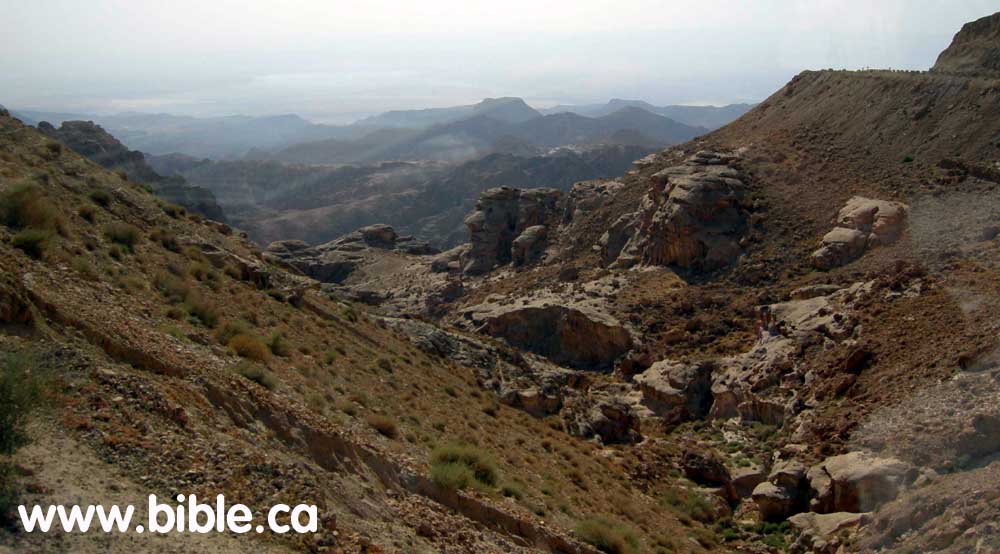
|
It was a reference used to determine the southern border of Israel and was just north of Kadesh Barnea (Near Petra): Numbers 34:4; Joshua 15:3
We feel the best candidate for the Ascent of Akrabbim is indicated by the blue #1 on the map below that starts at the dead sea and travels east from modern "Feifa" to "At Tafilah" in Jordan. Our close second choice, is blue #2 on the map below that starts from the Arabah valley and goes up the ravine to Dana, Jordan.
Traditionally, ascent of Akrabbim, has always been looked for on the western edge of the Arabah valley, but we feel this is wrong and that an easterly ascending path towards modern Jordan is the best choice. There are two reasons for this choice. First, the Bible says that the Ascent of Akrabbim is north of, but not part of the wilderness of Zin. Joshua 15:3 (Kadesh Barnea was in the wilderness of Zin). Second, Judges 1:36 defines the territory of the Amorites during the period of the judges at about 1200BC to be upward from both the ascent of Akrabbim and Petra. We know that the Amorites were transjordan at this time. It makes better sense to use and easterly ascending path into the territory of the Amorites, rather than the traditional westerly route that ascends into the actual territory occupied by Judah at that time. Of the two candidate "easterly ascending: routes, only the northern one (blue #4 on map) fits all the Bible data perfectly.
A major discovery was made by looking at a single Bible verse: Judges 1:36. We can determine that the ascent of Akrabbim was on the east side of the Arabah valley because of Judges 1:36: "The border of the Amorites ran from the ascent of Akrabbim, from Sela [Petra] and upward." While some may argue that Sela does not refer to Petra, although we know it does, everyone agrees the territory of the Amorites is transjordan. So if the ascent of Akrabbim is being used as a boundary marker for the borders of the Amorites, then the ascent of Akrabbim must be tranjordan. It would make no sense to mark the boundary of the Amorites if the ascent of Akrabbim is on the western side of the Arabah because everyone knows the Amorites were located in what is Modern Jordan at the time of Joshua.
Another evidence that the ascent of Akrabbim travels east from the Arabah Valley up onto transjordan Jordan, and not west into the land of Judah, is the scant references to it in the rest of the Bible. If it was within the land of Judah, as is traditionally suggested (blue #3 on the map below) then we should find several references to it within the normal course of events. But we find this same pattern of lack of references to all the exodus route locations outside the boundaries Israel: ascent of Akrabbim, Kadesh, wilderness of Zin, wilderness of Paran, Mt. Sinai.
A. What the Bible says about the ascent of Akrabbim:
B. How to interpret Judges 1:34-36:
"Then the Amorites forced the sons of Dan into the hill country, for they did not allow them to come down to the valley; yet the Amorites persisted in living in Mount Heres, in Aijalon and in Shaalbim; but when the power of the house of Joseph grew strong, they became forced labor. The border of the Amorites ran from the ascent of Akrabbim, from Sela and upward." Judges 1:34-36
|
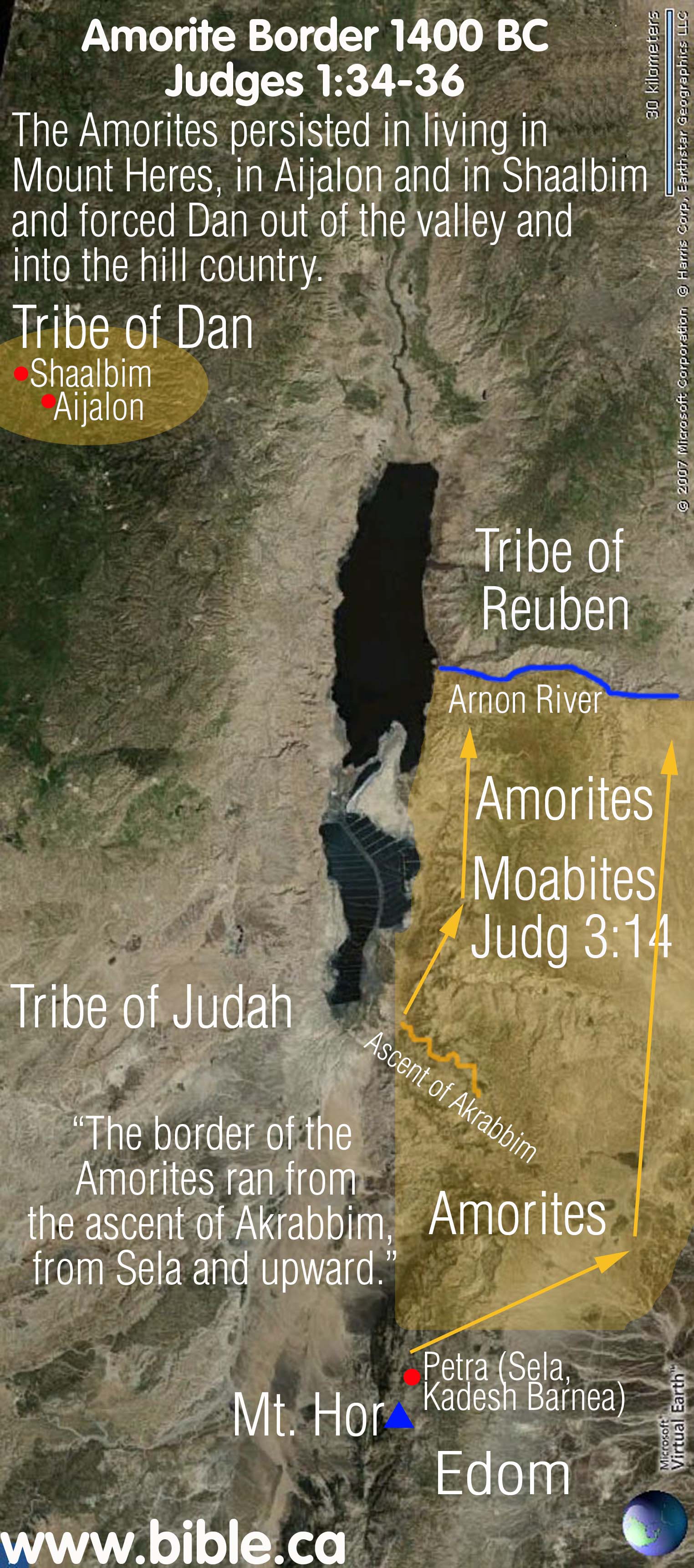
|
In 1406 BC, when the Israelites first came to the promised land, the Amorites controlled the transjordan from the Arnon River to Mt. Hermon and many key cities west of the Jordan including Jerusalem and Hebron. However, after defeating the Amorites, with God's help, they were displaced south of the Arnon River to Petra. But they retained one small stronghold west of the Jordan in the territory of Dan, where they occupied Mount Heres, Aijalon and Shaalbim.
In a kind of domino effect, just as Reuben displaced the Amorites moved south and displaced the Moabites and the Edomites. The Edomites were in turn, displaced south to Mt. Seir, (just north east of the Red Sea).
When Israel first crossed the Jordan with Joshua, the Amorites controlled both Hebron, Jerusalem and Engedi. They were defeated and driven transjordan between the time of Joshua to David.
Of course under David and Solomon, they were completely driven east and south of the entire transjordan area for a time, until the Assyrian captivity in 722 BC.
|
Discussion:
D. Photo gallery of the ascent of Akrabbim
(blue number 1 on map)
(Click on photo for high resolution)
|
Travelling along Highway # 60 starting from the Arabah Valley very near the Dead sea looking south.
|
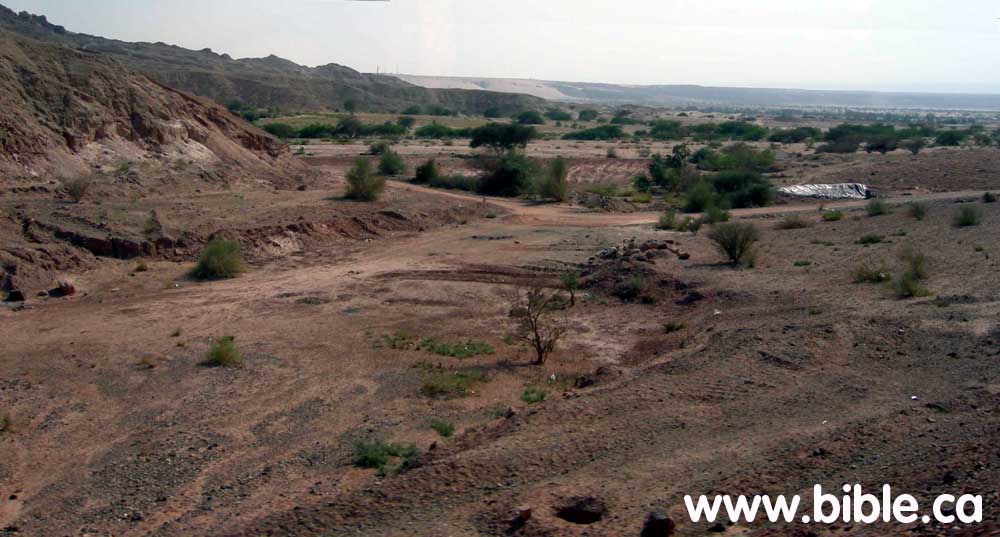
|
|
Travelling along Highway # 60 looking east up the wadi valley. You can see the local dirt road used by the Bedouin.
|

|
|
Travelling along Highway # 60 looking east up the valley.
|
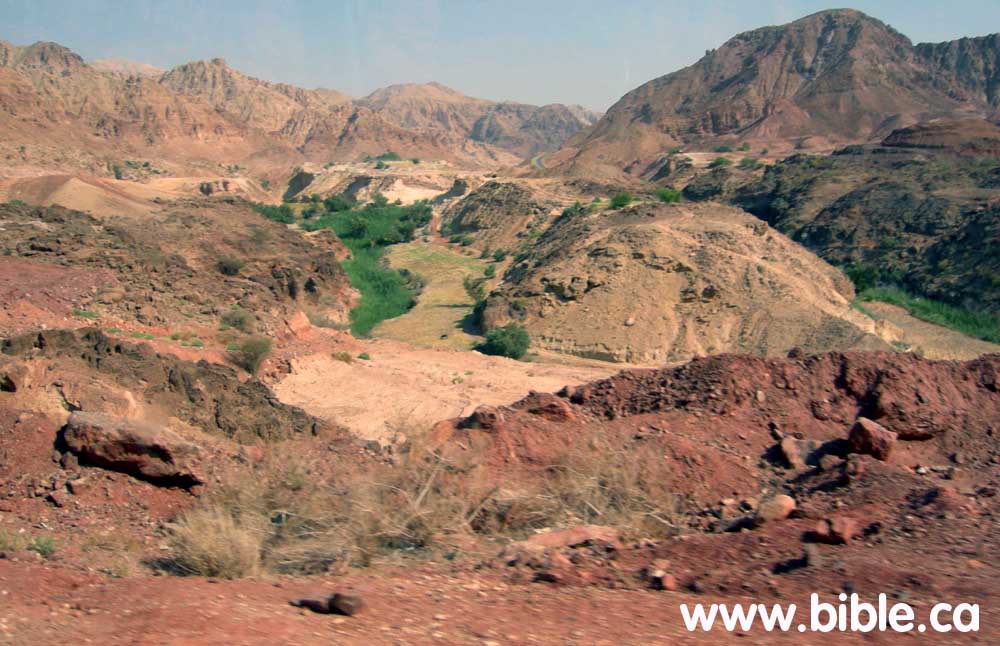
|
|
Travelling along Highway # 60 looking west and down an intersecting wadi with an oasis (running water)
|
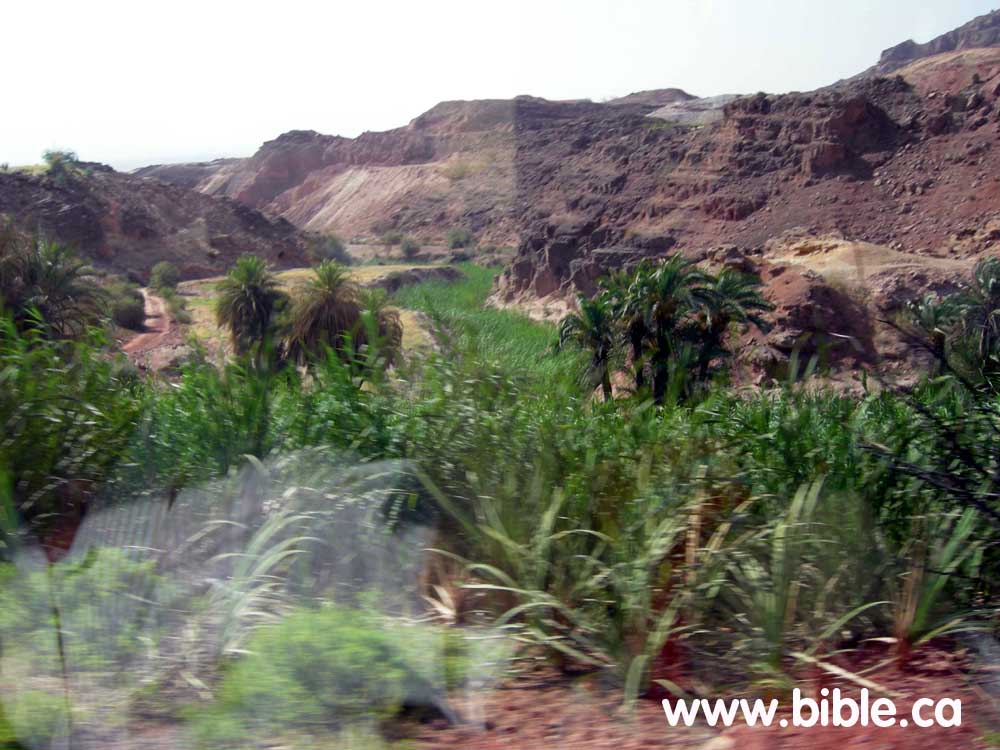
|
|
Travelling along Highway # 60 looking west from the top of the plateau to the Arabah Valley.
|

|
|
Travelling along Highway # 60 looking west to the Arabah Valley.
|
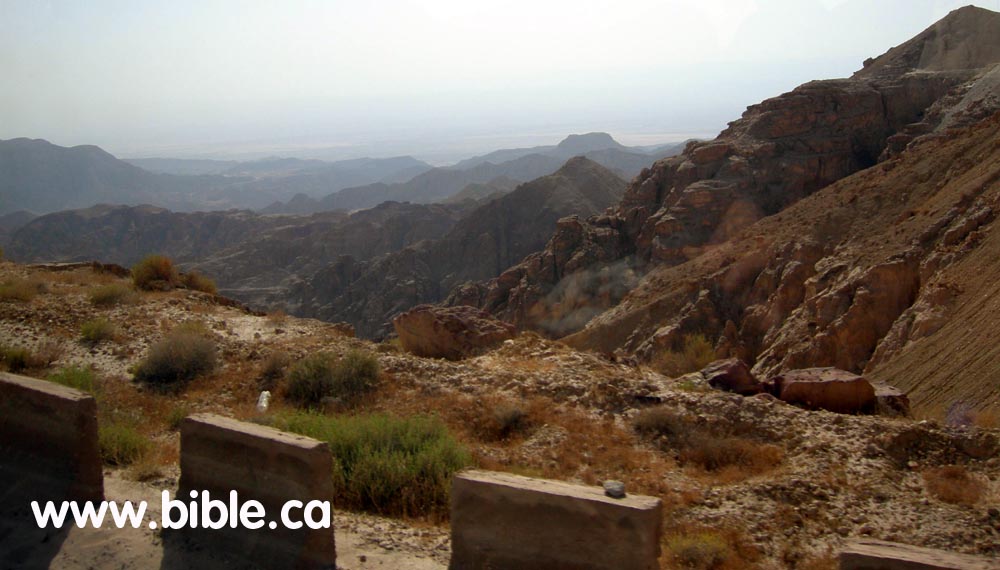
|
|
Travelling along Highway # 60 looking west to the small downs that dot the plateau. This is modern "At Tafila" in Jordan where it intersects with Highway #35.
|
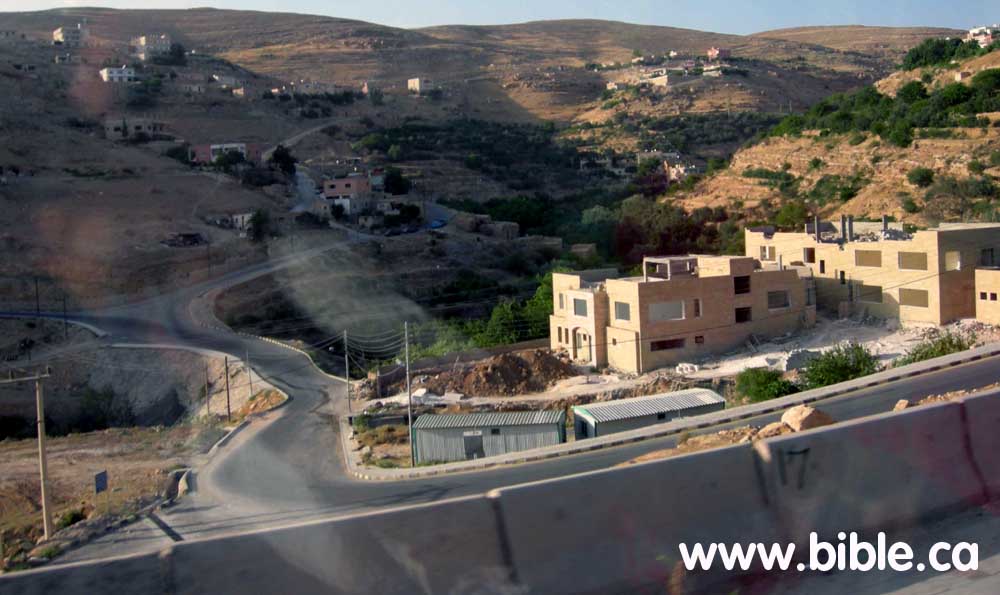
|
E. The traditional (wrong) location of the ascent of Akrabbim in Israel today:
|
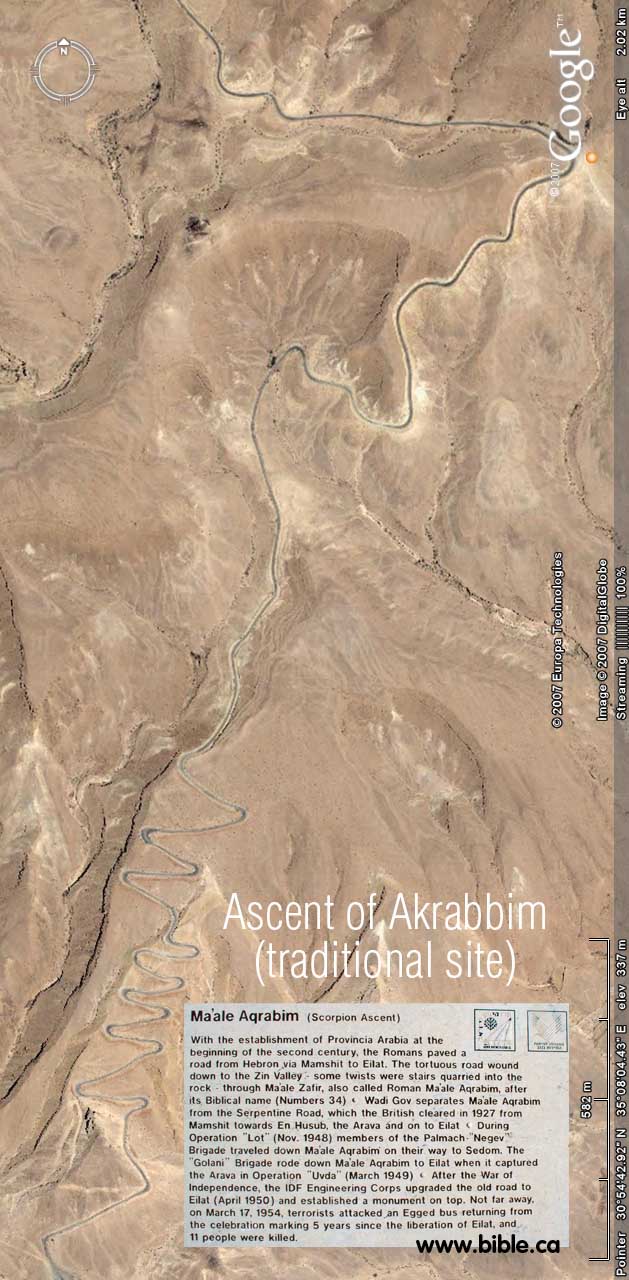
|
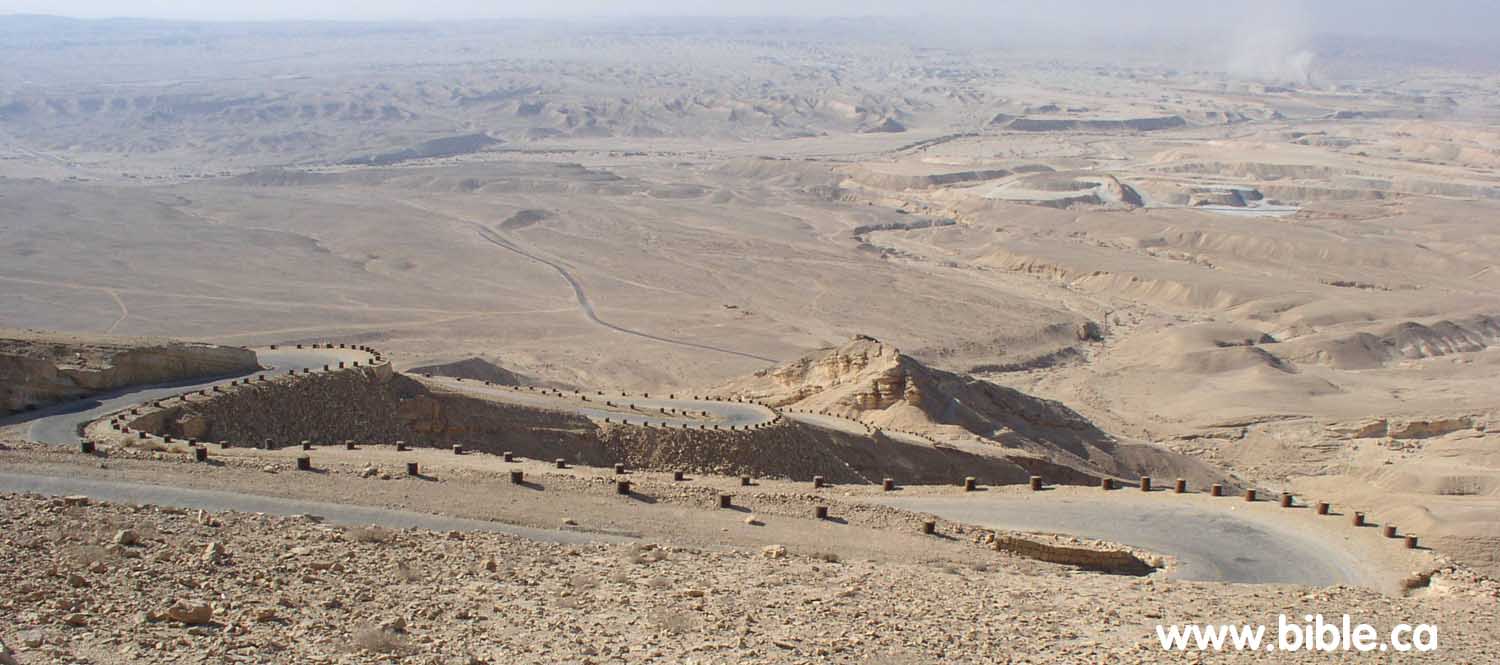
|
|
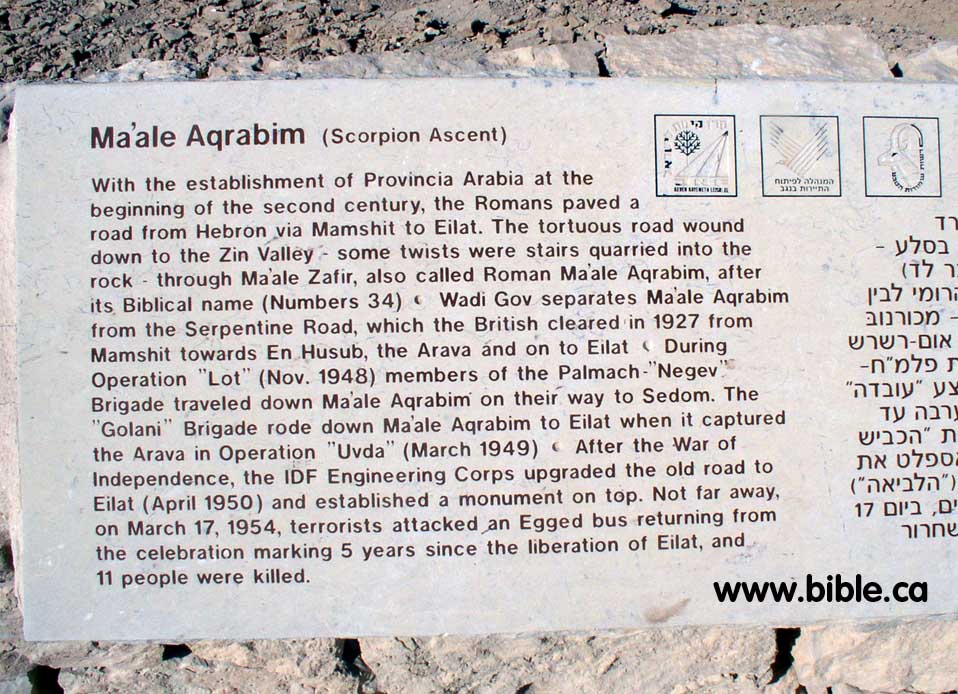
|
Ma'ale Aqrabim (Scorpion Ascent)
With the establishment of Provincia Arabia at the beginning of the second century, the Romans paved a road from Hebron via Mamshit to Eilat. The tortuous road wound down to the Zin Valley - some twists were stairs quarried into the rock - through Ma'ale Zafir, also called Roman Ma'ale Aqrabim, after its Biblical name (Numbers 34) Wadi Gov separates Ma'ale Aqrabim from the Serpentine Road,
|
|
which the British cleared in 1927 from Mamshit towards En Husub, the Arava and on to Eilat During Operation "Lot" (Nov. 1948) members of the Palmach-"Negev" Brigade traveled down Ma'ale Aqrabim on their way to Sedom. The "Golani" Brigade rode down Ma'ale Aqrabim to Eilat when it captured the Arava in Operation "Uvda" (March 1949) After the War of Independence, the IDF Engineering Corps upgraded the old road to Eilat (April 1950) and established a monument on top. Not far away, on March 17, 1954, terrorists attacked an Egged bus returning from the celebration marking 5 years since the liberation of Eilat, and 11 people were killed." (highway inscription)
|
F. In 1847 AD the ascent of Akrabbim was located near
Ma'ale Aqrabim:
Rabbi Joseph Schwarz may in fact be the one who is responsible for misleading the search for Kadesh Barnea in the first place. He wrongly places Kadesh south of Gaza based upon similarity of names between several languages.
|
Descriptive Geography and Brief Historical Sketch of Palestine.
By Rabbi Joseph Schwarz
Map by Rabbi Joseph Schwarz in 1847 of promised land
1847 AD
The Ascent of Akrabbim
מעלה עקרבים
Means literally the ascent of Scorpions, so to say, a most dangerous hill. The celebrated Saadia renders it, in his Arabic translation of the Scriptures, Ali Akbah Akrabin, i.e. or the country of Akbah Akrabin. The Arabs call the eastern bay of the Red Sea, Bachr Akabah; also the entire valley, from the Dead to the red Sea, they call ערבה Araba, Al Gor, also Akabah (see father down, art. Kikkar Hayarden ככר הירדן ). It is therefore to be presumed that this ascent of Akrabbim must be sought for in this valley. And, in truth, westward from the village Chansiri, on the edge of Al Gor, not far from the Wady Kurahy, there is a fearfully high and precipitous rocky acclivity, which to pass is extremely dangerous; and I suppose this is to be the Ascent of Akrabbim, here mentioned. [footnote: I explain Judges 1:36, וגבול האמרי ממעלה עקרבים מהסלה ומעלה "And the coast of the Amorite was from the going up of Akrabbim, from the rock and upward," to refer to the city Selah, mentioned in 2 Kings 14:7, which was also called Joktheel, and at a later period Petra, and which is also found in this Al Gor; and this leads us to place the ascent of Akrabbim northward of Selah or Petra.]
Kadesh-Barnea
. קדש ברנע
No geographer or traveller has hitherto succeeded to discover a trace of this place, But I believe that, through means of our own literary treasures, I shall be able to throw some light on this obscure name, so that it will be possible to fix its position with some degree of certainty.
Our commentators Onkelos, Jonathan, and the Targum Yerushalmi, all translate Kadesh-Barnea with רקם גיעא Rekam Gaya. In this connexion I have also discovered that the Wady al Arish (see farther down, under Nachal Mitzrayim נחל מצרים), united eastwardly with another Wady, which the Arabs call Wady Abiat (White Valley), or Wady Gaian. Another Wady, called by them Wady Bierin, is connected on the southeast with the Wady Gaian. I have scarcely any doubt but that the name of Gaian is derived from the ancient Rekam Gaya, and that Bierin is derived from the ancient Barnea; although the Arabs believe that this name is applied to the Wady because there are found in it several wells. I therefore believe that the true position of Kadesh-Barnea is to be found at the point where the Wadys Gaian and Bierin unite; and this is about 45 English miles south of Gaza
|
G. Here are photos of a scorpion taken near the ascent of Akrabbim in Israel:

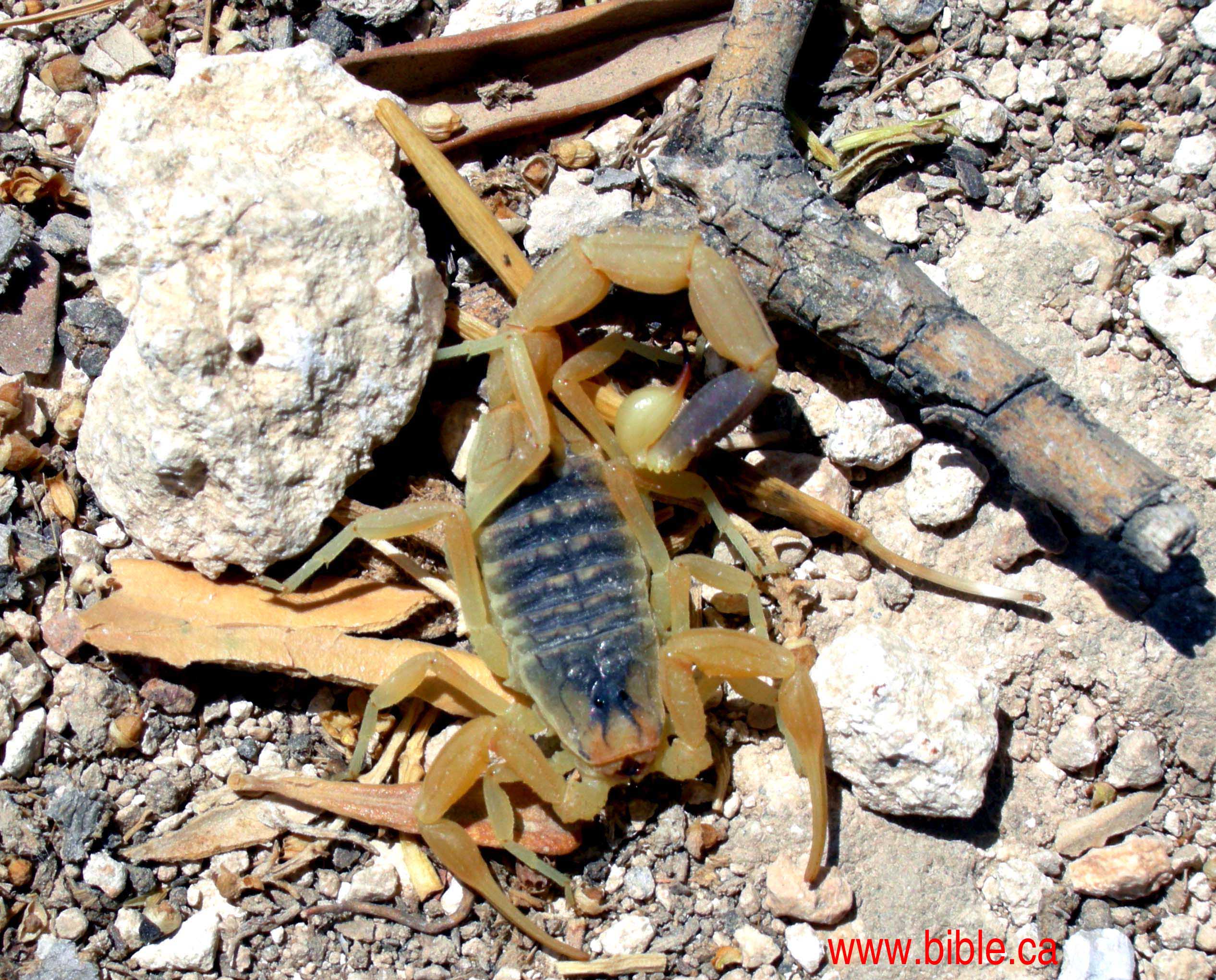
Click here for a complete discussion on the Amorites
Judges 1:34-36 recounts places where Israel failed to drive out the Amorites within the promised land. The narrative begins in the tribe of Dan, an area just north west of Jerusalem and how the Amorites occupied key areas within Dan's inheritance. It mentions two towns of Aijalon and Shaalbim whose location we can generally identify.
Oddly, though, the narrative then gives the border of the Amorites starting from the "Arabah Valley and upward". Such a border definition would basically include 80% of the promised land. Its like saying, the territory of the Amorites is everything north of the southern end of the Dead Sea. So what shall we make of this?
It is important to note a few things about the words in this verse. The word "upward" is common and non-specific. The word "border" is the common word for denoting territory or a border. But it is well known in the Bible that the expression "went up" or "went down" referred to elevation. For example: "Joseph went up from the Nazareth (350 meters above sea level) to Bethlehem (600 m)" Luke 2:4. And again: "Jesus went down (from Cana of Galilee 250 m) to Capernaum (-150 m), then Jesus went up to Jerusalem (750 m)." John 2:11-13. Therefore, the word, "upward" as it is used in Judges 1:36 likely refers to elevation.
So when we apply this common Jewish usage of "upward" in Judges 1:36, we read the text: "The area occupied and controlled by the Amorites started in the valley of the Arabah (50 m) and went up in elevation into the promised land from there."
The two lowest beginning points are the "ascent of Akrabbim" and "Sela" (or Petra). At the time of the failed conquest immediately after the spies came back and gave a bad report, it was the Amorites that repelled the disobedient Jews out of the Negev and back to Petra (Kadesh Barnea was located at or near Petra.)
Now we need to discuss how this impacts our choice of where the "ascent of Akrabbim" is located. There are in fact, 5 possible choices of where this ascent is located. Can Judges 1:36 give us any clues as to which side of the Arabah valley the ascent of Akrabbim on? Since Sela (Petra), is a known location on the east side of the Arabah valley, it seems logical to expect that the ascent of Akrabbim would be located on the west side. If this were truly the case, then it would indicate that the Amorites occupied from the upward and westward ascent of Akrabbim and upward and eastward from Petra. This would make good sense, since Judges 1:34-36 starts with the Amorite occupation of the territory of Dan "upward and west" of the Arabah valley. But this may not be the case, as there are other options.
If the ascent of Akrabbim is located on the eastern Arabah valley ascending upwards towards modern Jordan, as we believe it does, the text of Judges 1:34-36 also fits nicely. Since the Amorites were a very powerful nation, when Israel displaced them, they in turn displaced the Moabites and the Edomites out of their territory in 1406 BC. Remember, the Amorites had the territory north of the Arnon River and controlled Jerusalem, Hebron etc. The tribe of Reuben, Gad and Manassah possessed the territorial stronghold of the Amorites between the Arnon River and Mt. Hermon.
Keeping this in mind when reading Judges 1:34-36, means that the Amorites moved south of the Arnon River, displaced the Moabites and Edomites down as far as the ascent of Akrabbim (east side of the Arabah at the base of the Dead Sea ascending into modern Jordan) and Petra. The one exception was a tiny stronghold in the tribe of Dan as Judges 1:34-36 indicates.
C. Locating the ascent of Akrabbim: (Five possible choices)
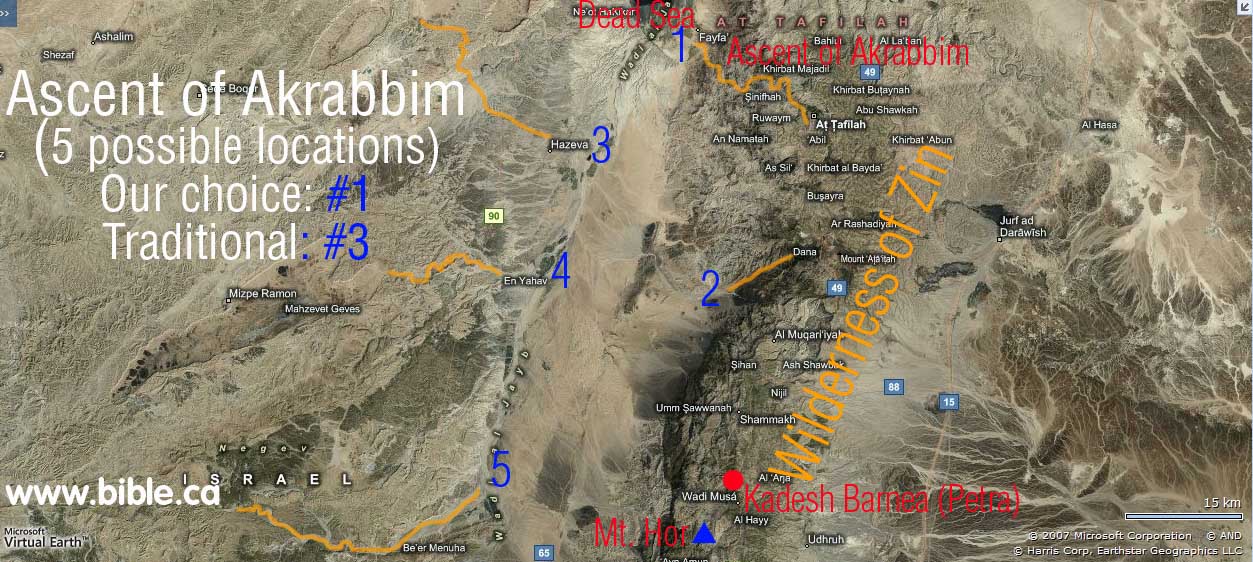
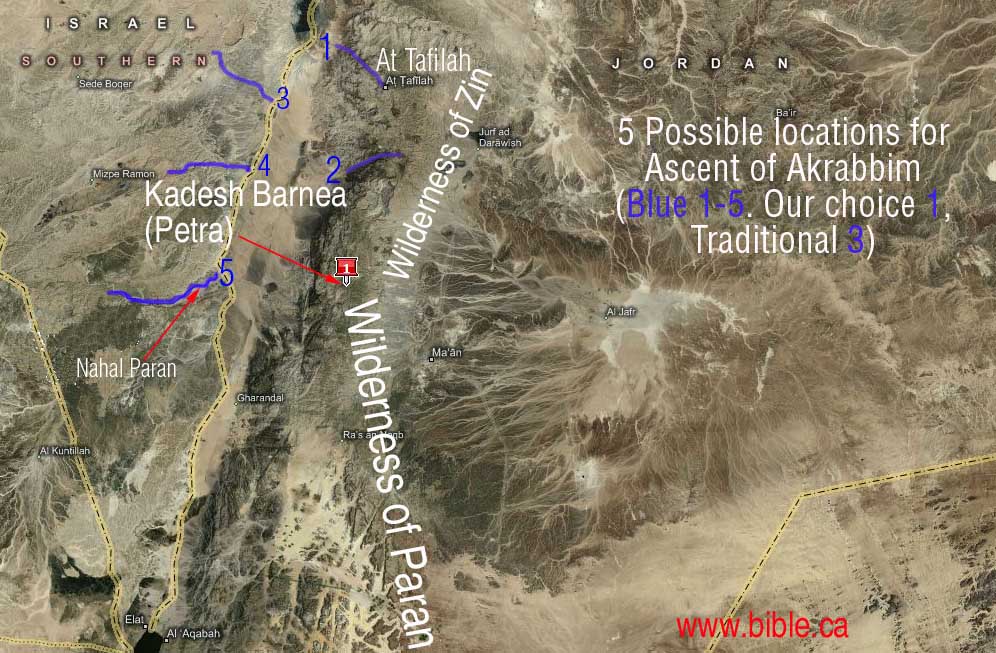
(blue #1 on map) Our choice for the ascent of Akrabbim is marked by the blue #1 on map. The most likely easterly ascending route would follow Highway #60. The modern highway attests to its ancient usage. This route starts immediately at the bottom of the Dead Sea and moves up the ravine to the modern town of "At Tafila". Today, this route is the only modern highway (Highway #60) for cars between the Arabah Valley and the plateau in modern Jordan between the Dead sea and the Gulf of Aqaba (Red Sea). Jordanian Highway #60 starts at the town of Fifa in the Arabah Valley and passes through At Tafila and continues east. Here at At Tafila, it intersects with Highway #35. Highway #35 travels north to Amman and south through Petra and all the way to the Gulf of Aqaba. (After connecting with Highway #15. Highway #35 is the main route between the Aqaba and Amman and #15 is the western most highway in Jordan that traces the high ridges on top of the Arabah Valley and is very scenic. The mountains on the eastern Arabah valley are very high (similar to the Rocky Mountains in Canada) and form such a formidable barrier that there is no way to get from the valley into the Jordan Plateau except at either end of the range at the Dead Sea end via Highway 60 or Red Sea via Highway 35. This is the territory of Edom. God told Edom "The arrogance of your heart has deceived you, You who live in the clefts of the rock, In the loftiness of your dwelling place, Who say in your heart, 'Who will bring me down to earth?' "Though you build high like the eagle, Though you set your nest among the stars, From there I will bring you down," declares the Lord." Obadiah 3-4 But for man it was an untouchable fortress.
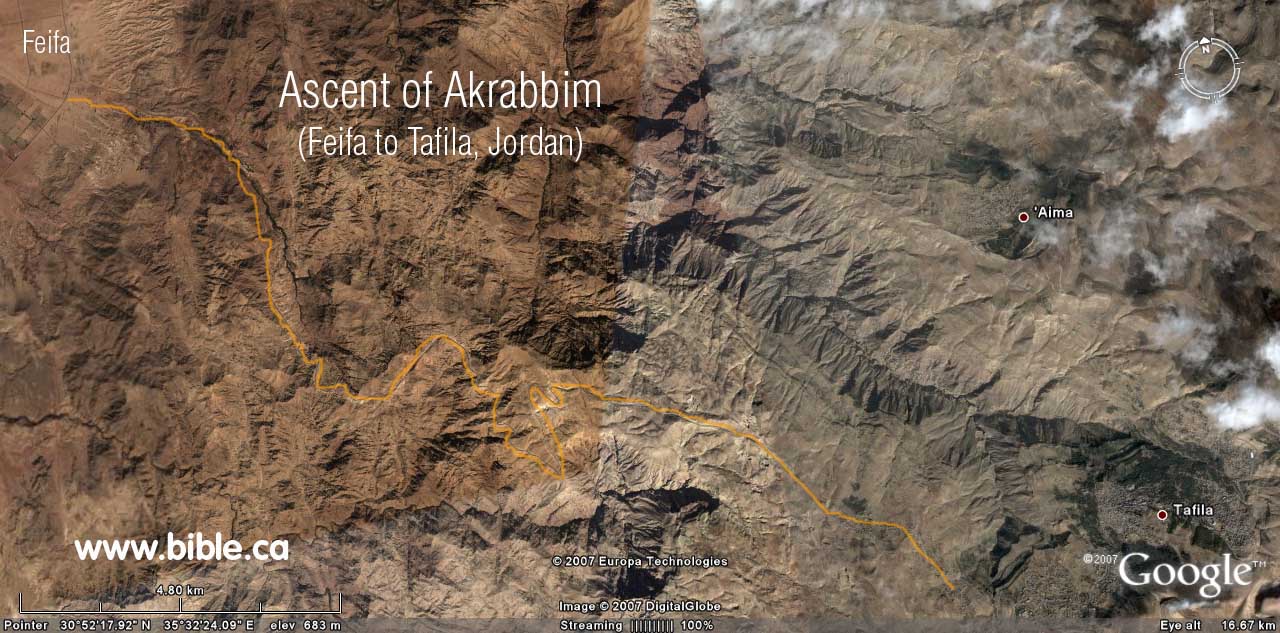 (blue #2 on map) Our second choice for the ascent of Akrabbim starts on the eastern edge of the Arabah valley and ascents eastward into modern Jordan. Although there are two possible routes, the most likely route starts 35 km south of the Dead Sea, due north of Petra, and exactly opposite Nahal Paran and ascends into Modern Jordan. This route is quite obvious since it follows a major geological valley canyon from the Arabah valley east, onto the plateau in modern Jordan. Further, this
(blue #2 on map) Our second choice for the ascent of Akrabbim starts on the eastern edge of the Arabah valley and ascents eastward into modern Jordan. Although there are two possible routes, the most likely route starts 35 km south of the Dead Sea, due north of Petra, and exactly opposite Nahal Paran and ascends into Modern Jordan. This route is quite obvious since it follows a major geological valley canyon from the Arabah valley east, onto the plateau in modern Jordan. Further, this
 (blue #3 on map) This is the modern choice of location of the ascent of Akrabbim. This route, although it is not the ascent of Akrabbim, does indeed travel along an ancient route from the Arabah valley, through one of Solomon's border fortresses he built at Ein Haseva and into the promised land. It matters not that we reject this as the location for the Ascent of Akrabbim, for the fact remains that this was an ancient route used from the time of Solomon. Although it is a possible location for the Ascent of Akrabbim, there is a better transjordan choice, on the east side of the Arabah valley. (blue #1)
(blue #4 on map) This possible location for the Ascent of Akrabbim, is located half way between Nahal Paran and the Dead Sea on the west side of the Arabah valley, 35 km south of the Dead Sea. Although its path is not known for sure, it likely begins from the Arabah valley near the modern town of En Yahav and follows the wadi drainage path that leads to the south eastern end of Mizpe Ramon crater. If not towards the Mizpe Ramon crater, then it branches north along the same wadi onto the plateau.
(blue #5 on map) Another option, however is that the Ascent of Akrabbim follows the Nahal Paran. This is 65 KM south of the dead sea and is located on the east side of the Arabah valley ascending westward towards the Wadi El Arish drainage system. This is unlikely since it really is not much of an ascent, but a flat wide drainage area. Below is a photo of the center of the Nahal Paran ditch facing west towards Mt. Karkom ascending up the bank out of the valley on highway #40 where Nahal Paran intersects Nahal Sira. As you can see, it is not much of an ascent, more like a wide flood plain. It is not likely that the Nahal Paran is the ascent of Akrabbim.
(blue #3 on map) This is the modern choice of location of the ascent of Akrabbim. This route, although it is not the ascent of Akrabbim, does indeed travel along an ancient route from the Arabah valley, through one of Solomon's border fortresses he built at Ein Haseva and into the promised land. It matters not that we reject this as the location for the Ascent of Akrabbim, for the fact remains that this was an ancient route used from the time of Solomon. Although it is a possible location for the Ascent of Akrabbim, there is a better transjordan choice, on the east side of the Arabah valley. (blue #1)
(blue #4 on map) This possible location for the Ascent of Akrabbim, is located half way between Nahal Paran and the Dead Sea on the west side of the Arabah valley, 35 km south of the Dead Sea. Although its path is not known for sure, it likely begins from the Arabah valley near the modern town of En Yahav and follows the wadi drainage path that leads to the south eastern end of Mizpe Ramon crater. If not towards the Mizpe Ramon crater, then it branches north along the same wadi onto the plateau.
(blue #5 on map) Another option, however is that the Ascent of Akrabbim follows the Nahal Paran. This is 65 KM south of the dead sea and is located on the east side of the Arabah valley ascending westward towards the Wadi El Arish drainage system. This is unlikely since it really is not much of an ascent, but a flat wide drainage area. Below is a photo of the center of the Nahal Paran ditch facing west towards Mt. Karkom ascending up the bank out of the valley on highway #40 where Nahal Paran intersects Nahal Sira. As you can see, it is not much of an ascent, more like a wide flood plain. It is not likely that the Nahal Paran is the ascent of Akrabbim.
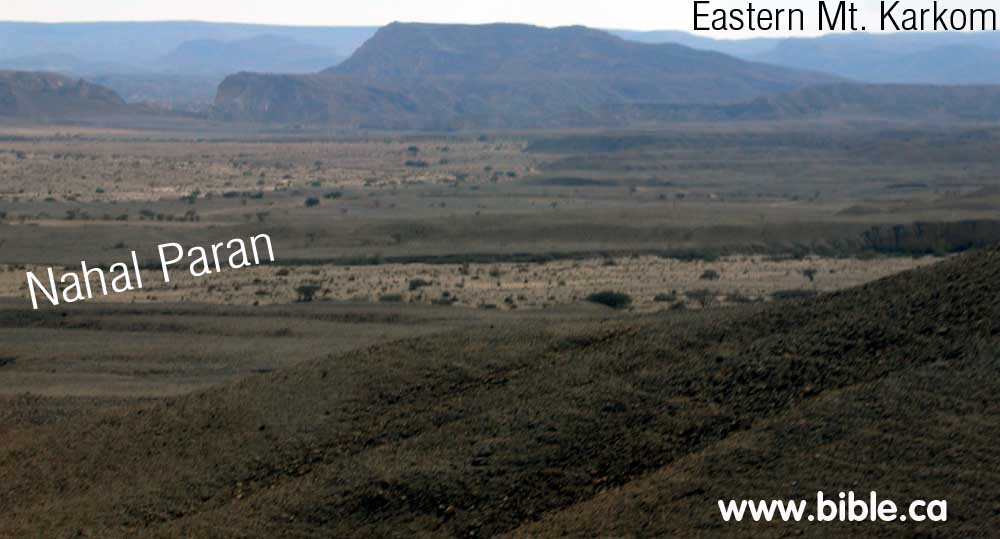 "Then your border shall turn direction from the south to the ascent of Akrabbim and continue to Zin, and its termination shall be to the south of Kadesh-barnea; and it shall reach Hazaraddar and continue to Azmon." Numbers 34:4
"Then it proceeded southward to the ascent of Akrabbim and continued to Zin, then went up by the south of Kadesh-barnea and continued to Hezron, and went up to Addar and turned about to Karka." Joshua 15:3
"The border of the Amorites ran from the ascent of Akrabbim, from Sela [Petra] and upward." Judges 1:36
"Then your border shall turn direction from the south to the ascent of Akrabbim and continue to Zin, and its termination shall be to the south of Kadesh-barnea; and it shall reach Hazaraddar and continue to Azmon." Numbers 34:4
"Then it proceeded southward to the ascent of Akrabbim and continued to Zin, then went up by the south of Kadesh-barnea and continued to Hezron, and went up to Addar and turned about to Karka." Joshua 15:3
"The border of the Amorites ran from the ascent of Akrabbim, from Sela [Petra] and upward." Judges 1:36
|
|
|
|
|
|
|
|
Caín y Abel
Toda la historia de Caín y Abel se puede encontrar aquí . En aras de la brevedad, Caín y Abel eran hermanos, los dos únicos hijos de Adán y Eva. Ambos hicieron sacrificios a Dios, Caín ofreció lo que él creció y Abel ofreció al primogénito de su rebaño. Como Caín comenzó a ver a Dios mostrando más favorable para que Abel, él se enojó. Cuando Dios se dio cuenta, le aconsejó a Caín para dominar sus deseos, lo que hizo Caín asesinando a Abel. Por eso, Dios lo maldijo y lo despidió. Cuando Caín pidió clemencia, Dios puso una marca en él para protegerlo. Caín salió de Edén para la tierra de Nod, encontró una esposa, construyó una ciudad y y vivieron felices para siempre.
15 Entonces el Señor le dijo: "No es así! Si alguno mata a Caín, será castigado siete veces." Y Jehová puso una señal a Caín para que nadie que le encontrase le debe matar. (Gen. 4 : 15)
16 . Caín salió de la presencia de Jehová, y habitó en tierra de Nod, al oriente de Edén
17 conoció Caín a su mujer, la cual concibió y dio a luz a Enoc; y edificó una ciudad, y llamó el nombre de la ciudad después de que el nombre de su hijo, Enoc. (Génesis 4:16-17)
La leyenda tiene lugar cuando el Sol está en Escorpio . Hércules personifica Abel y Caín Ofiuco personifica. Hay dos razones por las que conocemos Ofiuco personifica Caín. En primer lugar, es la celebración de una serpiente. En segundo lugar, la cabeza está representada por sólo una estrella, que sería la marca de Caín. (He resaltado Ras Alhague con un punto amarillo.) En una escala de -1 a 19 , con -1 siendo el más brillante, Ras Alhague tiene una magnitud de 2,1. Eso es fácilmente visible y cercano en magnitud a la estrella Polaris Norte.
En cuanto a Abel, lo vemos al revés como el hermano muerto acostado sobre su espalda. (Podemos ignorar las manzanas y el club en sus manos;. Que viene del mito de Hércules) Piscis representa la justicia mete a Caín después del asesinato de Abel. A medida que el sol se desplaza hacia Virgo, Caín se desvanece y vemos la esposa de Caín, Virgo.
Voy a tener una pista sobre lo que "al este del Edén" se entenderá, en el paradero de la tierra de Nod: A medida que los días pasan, las estrellas a la deriva hacia el oeste hasta que se establecieron en el oeste. Unos meses más tarde se levantan en el este de nuevo. Así que para ancianos, el oeste y el este simboliza la muerte simboliza la vida. Significa Nod es existente. El malvado Caín simboliza a los enemigos de los hebreos, tal vez Babilonia.

|
|
|
|
|
|
|
BET EMET MINISTRIES
Hebrew For "The House Of Truth"
Craig M. Lyons Ms.D., D.D., M.Div.
bennoah1@verizon.net
TRACING THE SUN THROUGH THE ZODIAC & SCORPIO...COULD THIS BE THE ORIGIN FOR THE "JESUS STORY" #12
SCORPIO AND JESUS: OCTOBER 24 - NOVEMBER 21
We have been following the path of the Sun through the Zodiac and by now you should be amazed at what you have seen in regards to the "Jesus Story" as found depicted in the New Testament and the unbelievable unique parallels to the path of the Sun in the Heavens when personified. We have seen that the "Jesus Story" and all other similar stories of the Sun personified in previous non-Jewish nations since time began find their genesis in the Ancients' acknowledgment and understanding of the Precession of the equinoxes.
H.P. Blavatsky stated that the story of Jesus was invented after the 1st century. Jesus, she says, is a deified personification of the glorified type of the great Hierophants of the Temples, and his story, as told in the New Testament, is an allegory, assuredly containing profound esoteric truths, but still an allegory. . . . Every act of the Jesus of the New Testament, every word attributed to him, every event related of him during the three years of the mission he is said to have accomplished, rests on the program of the Cycle of Initiation, a cycle founded on the Precession of the Equinoxes and the Signs of the Zodiac (H.P. Blavatsky, Collected Writings, Wheaton, IL: Theosophical Publishing House, 1950-91, 9:225), H.J. Spierenburg (comp.), The New Testament Commentaries of H.P. Blavatsky, San Diego, CA: Point Loma Publications, 1987.
Answer for yourself: Why did this come about?
The Ancients saw the universe and their immediate environment, as well as the capacities embodied within their own intellect, trustworthy representations of the Creator God. The Universe (terrestrial and celestial) appeared to our ancestors as the only authentic image of the Father. The Cosmos was undoubtedly His Handiwork and we, the human creation, were likewise the Handiwork of the Almighty. The ancients personified the elements of the Cosmos and recorded the movements of the stars and planets as personified deities. From observations of the Sun and the constellations and their movement over thousands of years the Ancients captured Divine Truths witnessed in the Cosmos. Research has indisputable proved that the religions of the world are markedly similar in their teachings and ethical precepts and symbols by which they express their leading beliefs. This similarity, amounting in many cases to identity, proves accordingly that they all have a common origin...the Sun and the Heavens above. To the Ancients God was a composite photograph of innumerable Gods who are the personifications of the forces of nature. The fact that so many saviors were alleged to have been born on the same day of the year, under the same and similar circumstances in different parts of the world throughout history, indicates a common mythology. All these saviors, as personifications of these forces of nature like the Sun, including Jesus, can be referred to as solar gods because their births, lives and deaths can be correlated to the transit cycles of the Sun. Once this is understood then one can look at Sun-worship and the pure forms of nature-worship as they existed in their day and see them as noble religions, highly allegorical, but full of profound truth and knowledge as we have shown on our website concerning the Egyptian-Christian religion.
Having now understood this then it is easy to further see that Christianity is the restatement of a very old religious doctrine which has lost its original understanding and which is erroneously taught today as if Jesus, the personification of the Sun, was a historical and "literal man" when as you are seeing it is little more than the personification of the path of the Sun through the Heavens. This religion is not new and the early Church Fathers knew and admitted it.
Tertullian goes on to say, “You say we worship the Sun; so do you.” (Catholic Encyclopedia, xiv, 525; Ad. Nationes, xiii; Ante-Nicene Father. iii, 123) Tertullian went on to renounce Christianity and admitted that he was in error.
But we are finding that Tertullian was right the more we look at these articles on the "personified Sun" passed off as a historical Jesus. Now lets continue to track the Sun in its path in the sky as the "Jesus Story" continues.
We now move with the Sun having exited Libra we move with the Sun as it enters Scorpio.
Scorpius, the Scorpion, was the reputed slayer of the Giant (Orion) as he was about to slay Taurus, the Bull, exalted to the skies and now rising from the horizon as Orion, still in fear of the Scorpion, sinks below it.  Scorpio is a beautiful constellation and the heart of Scorpius is marked by the reddish star Antares. From this star three lines can be seen fanning out to three stars to the west which represent the claws of the animal. When the Sun passes through the stars of Scorpius, winter commences bringing the long dark days of the cold and damp season. In previous months of the year the Sun has passed through Virgo, the Virgin, bringing the season of harvest, and Libra, the Scales, bringing the season for weighing and trading the gathered crops. In Winter, the grain lies stacked in barns and cellars and it is in this season that vermin, amongst which may be counted the Scorpion, infest these stores. If one looks on a star chart, the tail of the Scorpion will be seen to lie in a dark portion of the Milky Way. This signifies that the Scorpion lives in dark crevices. It was sometimes thought that the dark portion of the Milky Way was perhaps a crevice leading to the Underworld whence the Scorpion emerged. It was also believed that the spirit of man descended into material existence through the Milky Way - the seed ground of the souls. Scorpio is a beautiful constellation and the heart of Scorpius is marked by the reddish star Antares. From this star three lines can be seen fanning out to three stars to the west which represent the claws of the animal. When the Sun passes through the stars of Scorpius, winter commences bringing the long dark days of the cold and damp season. In previous months of the year the Sun has passed through Virgo, the Virgin, bringing the season of harvest, and Libra, the Scales, bringing the season for weighing and trading the gathered crops. In Winter, the grain lies stacked in barns and cellars and it is in this season that vermin, amongst which may be counted the Scorpion, infest these stores. If one looks on a star chart, the tail of the Scorpion will be seen to lie in a dark portion of the Milky Way. This signifies that the Scorpion lives in dark crevices. It was sometimes thought that the dark portion of the Milky Way was perhaps a crevice leading to the Underworld whence the Scorpion emerged. It was also believed that the spirit of man descended into material existence through the Milky Way - the seed ground of the souls.
The scorpion is the symbol of both wisdom and self-destruction (darkness and winter). It was called by the Egyptians the creature accursed; the time of year when the Sun entered the sign of Scorpio marked the beginning of the rulership of Typhon (personified Darkness), an Egyptian destroying Demon or devil which was their form of "personified darkness". Typhon waited to devour all who failed to pass the Judgment of the Dead, which rite took place in the Hall of Justice between the earth and the Elysian Fields. Calmet, in his Dictionary of the Bible, declares the scorpion to be a fit emblem of the wicked and the symbol of persecution. The dry winds of Egypt are said to be produced by Typhon, who imparts to the sand the blistering heat of the infernal world and the sting of the scorpion. The red star Antares in the heart of the celestial scorpion was considered the worst light in the heavens, KaIb al Akrab, or the heart of the scorpion, was called by the ancients the lieutenant or deputy of Mars. Antares was believed to impair the eyesight, often causing blindness (darkness) if it rose over the horizon at birth. This may refer again to the sand storm, which was capable of blinding unwary travelers.
That was a little background on Scorpio. Now we move on to the "Jesus Story".
We have seen up to now that the Sun, after crossing the Summer solstice, begins a slow decline in the heavens on its way to its own death at the Winter solstice. The Sun is getting weaker and the air is getting progressively colder. The Ancients remarked that the bitter bite of the cold of winter was like the sting of a scorpion. This is perfect symbolism for Scorpio. Scorpions are seen as crawling creatures who frequent cracks, holes and other secluded spots, so they are associated with acts of secrecy and evil and live in the security of darkness. When the Sun was passing through Scorpio then we should understand that is was a time of intense conflict between light and dark and heat and coldness.
Answer for yourself: Does the text in the Gospel of Matthew continue to follow the path of the Sun personified in the life of Jesus? Do we find Jesus moving toward his inevitable death? Yes we do.
Matt 20:17-19 17 And Jesus going up to Jerusalem took the twelve disciples apart in the way, and said unto them, 18 Behold, we go up to Jerusalem; and the Son of man shall be betrayed unto the chief priests and unto the scribes, and they shall condemn him to death, 19 And shall deliver him to the Gentiles to mock, and to scourge, and to crucify him: and the third day he shall rise again. (KJV)
In like manner we find that Jesus heads towards his death at Jerusalem starting with Matt. 20:17 and enters the city at Matthew 21:10. He knew he would meet his demise as we see from the above passage from Matt. 20:18-19. We have already seen that the reference to the "resurrection in 3 days" refers to birth of the Sun at the Winter solstice.
Answer for yourself: As we have seen the Sun is being challenged daily by darkness and should we expect possibly to find such a challenge in the Scriptures again? We should and we do. As indicated at this time of year following the Summer solstice where the Sun reached the peak of its glory and light the Sun begins to loses its strength daily as Darkness gains in strength daily as the earth continues to tilt more in its revolutions. We find this same phenomena expressed in the account of Jesus healing not just one but "two" blind men. "Two" being greater than "one" is but another symbolism of the increasing Darkness personified in the motif of "double Darkness". We should therefore take notice of the fact that this onslaught of Darkness overpowering the failing Sun is dramatized in the text by the account of Jesus encountering such overwhelming Darkness in the form of "two" blind men.
We next encounter some more Solar mythology in the account given by the writer of the Gospel of Matthew in describing Jesus' triumphal entry into Jerusalem on not one but two asses. As shown before in another article this is Solar mythology and not a true historical account. This should make us wonder if this Jesus entered the city of Jerusalem at all or if he even existed as a historical person because of the absurdity of this one account. Normal people rode one ass at a time but we are made to believe that Jesus, again as the personified Sun, rides not one but two "asses". When you begin the study of astrotheology for yourself you find that this absurd account refers to two prominent stars which the Sun rides (crosses) following the Summer solstice. The stars are Asellus Borealis (Northern Ass) and Asellus Australis (Southern Ass).
The harvest has been gathered, it is now time to sell the harvest. This is reminiscent of the last House of the Zodiac in which the Sun passed since scales are used in buying and selling the harvest. At the end of harvest time, when there is nothing left to sell, the money changers pack up and leave. Thus the Bible says, “Jesus entered the temple area and drove out all who were buying and selling there. He overturned the tables of the money changers.” Jesus, the Sun, representing the passage of time, has move out of Libra, the Scales of Justine, and the money changes as would be expected pack up and leave, because the season has passed and they are finished selling the harvest.
We next move past Jesus cleansing the Temple in Matthew 21:12-17. Jesus drives the moneychangers out of the temple in the fall of the year. We know this because the next piece to follow in the Gospel of Matthew is when Jesus cursed the fig tree when figs have no fruit. Jesus’ curses a fig tree for not bearing fruit.
As we enter the season of Autumn the leaves fall from the trees and the trees appear to wither. It is at this point in the story that Jesus is said to curse the fig tree and make it wither, a story which makes no sense if Jesus were a real person, but it makes perfect sense when understood as an allegory. It is simply Autumn, and Jesus, the personified Sun, who makes the seasons pass, causes the leaves to fall from the trees (Mark 11:20-25; Matthew 21:18-22)
Matt 21:17-20 17 And he left them, and went out of the city into Bethany; and he lodged there. 18 Now in the morning as he returned into the city, he hungered. 19 And when he saw a fig tree in the way, he came to it, and found nothing thereon, but leaves only, and said unto it, Let no fruit grow on thee henceforward for ever. And presently the fig tree withered away. 20 And when the disciples saw it, they marvelled, saying, How soon is the fig tree withered away! (KJV)
We are past the Autumn equinox. Accordingly the Sun is daily and progressively losing its strength as it moves toward its certain death at the Winter solstice. The leaves drop from the trees and the days become progressively colder. The struggle between Darkness and Light only intensifies and we see this in the next account of the challenge of Jesus' authority by the chief priests and elders of the people.
Death become the theme of Jesus' teachings as we see in the “Parable of the Wicked Husbandmen" in Matthew 21:33-46. Along with this notice also that Jesus’ parables are getting more violent.
For example:
Matt 21:38-39 38 But when the husbandmen saw the son, they said among themselves, This is the heir; come, let us kill him, and let us seize on his inheritance. 39 And they caught him, and cast him out of the vineyard, and slew him. (KJV)
We find that theme after theme from the mouth of Jesus deals with his soon coming violent death. We find this in the “Parable of the Wedding Feast”, Matt. 22:1-14.
Matt 22:1-6 1 And Jesus answered and spake unto them again by parables, and said, 2 The kingdom of heaven is like unto a certain king, which made a marriage for his son, 3 And sent forth his servants to call them that were bidden to the wedding: and they would not come. 4 Again, he sent forth other servants, saying, Tell them which are bidden, Behold, I have prepared my dinner: my oxen and my fatlings are killed, and all things are ready: come unto the marriage. 5 But they made light of it, and went their ways, one to his farm, another to his merchandise: 6 And the remnant took his servants, and entreated them spitefully, and slew them. (KJV)
Jesus denounces the scribes and the Pharisees, Matt. 23:1-39 (personified Darkness). He is angry.
Matt 23:38 38 Behold, your house is left unto you desolate. (KJV)
Matt 24:3 3 And as he sat upon the mount of Olives, the disciples came unto him privately, saying, Tell us, when shall these things be? and what shall be the sign of thy coming, and of the end of the world? (KJV)
In the Sermon on Mt. Olive, Matt. 24 Jesus talks about the coming of the end of the "age" (mistranslated as world in most versions). Jesus talks about tribulation. The end of the age occurs....
Matt 24:21 21 For then shall be great tribulation, such as was not since the beginning of the world to this time, no, nor ever shall be. (KJV)
Matt 24:29 29 Immediately after the tribulation of those days shall the Sun be darkened, and the moon shall not give her light, and the stars shall fall from heaven, and the powers of the heavens shall be shaken: (KJV)
By now you should understand the tribulation between Darkness and Light that occurs each year with the slow descending death of the Sun at the Winter solstice.
Matt 24:7-9 7 For nation shall rise against nation, and kingdom against kingdom: and there shall be famines, and pestilences, and earthquakes, in divers places. 8 All these are the beginning of sorrows. 9 Then shall they deliver you up to be afflicted, and shall kill you: and ye shall be hated of all nations for my name's sake. (KJV)
Matt 28:20 20 Teaching them to observe all things whatsoever I have commanded you: and, lo, I am with you always, even unto the end of the world. Amen. (KJV)
|
|
|
|
|
Next we have Judas plots to betray Jesus, Matt. 26:14-16.
Matt 26:14-16 14 Then one of the twelve, called Judas Iscariot, went unto the chief priests, 15 And said unto them, What will ye give me, and I will deliver him unto you? And they covenanted with him for thirty pieces of silver. 16 And from that time he sought opportunity to betray him. (KJV)
Let us recall that when the Sun crosses the Autumn equinox, it is allegorized as being arrested or betrayed by the dark forces. We find this expressly taught in the example of Judas' betrayal of Jesus as the personified Sun.
The symbolism of Scorpio end with the Passover supper, Matt. 26:26-29.
Matt 26:26-29 26 And as they were eating, Jesus took bread, and blessed it, and brake it, and gave it to the disciples, and said, Take, eat; this is my body. 27 And he took the cup, and gave thanks, and gave it to them, saying, Drink ye all of it; 28 For this is my blood of the new testament, which is shed for many for the remission of sins. 29 But I say unto you, I will not drink henceforth of this fruit of the vine, until that day when I drink it new with you in my Father's kingdom. (KJV)
In the Jesus story we then have the Last Supper, where Jesus and his twelve disciples, a reference to the twelve zodiac months of the year, recline and eat the long awaited harvest. (Mark 14:12-26; Matthew 26:17-30; Luke 22:7-38). This is the natural time of year to have a huge feast. In America we celebrate Thanksgiving and have a huge feast of food. We eat the flesh of the fruit-figuratively the flesh of Jesus, who personifies the Sun which make the fruit grow; and we drink wine-the blood of the grapes, figuratively the blood of Jesus, who personifies the Sun which made the grapes grow. Without this food we would perish. months of the year, recline and eat the long awaited harvest. (Mark 14:12-26; Matthew 26:17-30; Luke 22:7-38). This is the natural time of year to have a huge feast. In America we celebrate Thanksgiving and have a huge feast of food. We eat the flesh of the fruit-figuratively the flesh of Jesus, who personifies the Sun which make the fruit grow; and we drink wine-the blood of the grapes, figuratively the blood of Jesus, who personifies the Sun which made the grapes grow. Without this food we would perish.
The "Jesus Story" goes tragically downhill from there, just like in the season of Autumn the year tragically winds down and comes to an end as the days become shorter and colder. In October the Sun enters Scorpio, the Scorpion, which figuratively stings the Sun to make it slowly die. The days begin to get shorter and colder as the Sun rises and sets lower and lower each day. In the Jesus story Jesus is betrayed by Judas, one of the twelve zodiac months of the year. get shorter and colder as the Sun rises and sets lower and lower each day. In the Jesus story Jesus is betrayed by Judas, one of the twelve zodiac months of the year.
Judas represents Scorpio, the month of October. Judas betrays Jesus for 30 pieces of silver, representing the 30 days of the month as well as 30 degrees to each sign of the Zodiac. The month being one cycle of the phases of the moon. The moon was often thought by the Ancients to be little more than a piece of silver in the sky. The Sun (personified Jesus) was betrayed by one of his Disciples (zodiac signs). According to the dictionary, the word "betrayed" means "to deceive, to lead astray, to deliver into the hands of ones enemy." This clearly refers to the Sign (at the autumnal equinox) that leads the Sun (Jesus) into the hands of the enemy (below the celestial equator), where Darkness rules (where night is longer than day time). The Ancients wrote that the payment of Judas for his crime was thirty pieces of silver. They used the term "Silver" as a metaphor for Degrees. One sign of the Zodiac covers thirty degrees (thirty pieces) of arc. Thus we see that 12 Signs of the Zodiac equals 360 Degrees which is EXACTLY the total arc made by the twelve Signs of the Zodiac and encircles the globe exactly.
Answer for yourself: What have we seen so far?
We have seen that there are 12 “houses” in the Zodiac in which the Sun travels in a year. We have seen their dates throughout the year and have contrasted them with the life-stages of Jesus which parallel perfectly the life cycle or life stages of the Sun daily.
Answer for yourself: Is this coincidence? What are the chance of this? The Laws of Statistics tell us that this is impossible. The Sun goes through various stages.
- birth
- mature-fully grown
- passion and death
- rebirth
Answer for yourself: Are you aware that the first in a long line of proto-Jesus in antiquity was Horus, the Son of the Sun god? Let us look at the life stages of Horus as taken from the Ancients witness of the life cycle of the Sun in its daily and yearly path through the Heavens.
- Ra-Harakhte (Horus of the two horizons) This horus was identified with Ra and the daily voyage of the Sun from horizon to horizon. The two deities combined to become Ra-Harakhte. He was represented as a falcon or a falcon-headed man wearing the solar disk and double crown or the uraeus and the atef crown.
- Harpokrates (The infant Horus) As a child he represented the new born Sun and was often pictured being suckled by Isis. he was usually represented as a seated child, sucking his thumb, his head was shaved except for the sidelock of youth. Even as a child, he wore the royal crown and uraeus.
- Harmakhet (Horus in the Horizon) In this form he represented the rising Sun and was associated with Khepri. He was also considered to be the keeper of wisdom. He was sometimes pictured as a man with a falcon's head, or a falcon headed lion. But his most recognizable form is that of a sphinx, or as a ram-headed sphinx.
- Horus Behudety In the form of Horus of Edfu, he represented the midday Sun. This Horus was worshipped in the western Delta and later, as his cult spread south into Upper Egypt, a cult center was established in Edfu. Horus of Edfu fights a great battle against Seth and an army of conspirators. He is pictured as a winged sun-disk or as a hawk headed lion.
- Harmachis (Heru-Em-Akhet, Harmakis): "Horus in the horizon". Horus as symbol of resurrection, linked with the setting Sun.
Answer for yourself: Is Jesus, personified as the Sun, little more than the representation of the path and life cycle of the Sun as was Horus? Was Jesus another Horus on the horizon? We have seen in following the life and ministry of Jesus in the "Jesus Story" that he, like Horus, both travel from birth, maturity, passion, death, and rebirth? Is this coincidence? Is it? Have you ever looked at the similarities between the Jesus in the New Testament and Horus?
We have chronicled the dates corresponding to these above life-stages in the life of Jesus in the "Jesus Story" in the New Testament. The Ancients were correct in seeing the Sun and its light as indispensable to life, but at the same time they constantly worried that as daylight hours got shorter, the Sun was endangered of dying a permanent death. When sunlight hours began to increase again, they were relieved and interpreted this as their salvation; literally the salvation of and from God their Creator.
Thus darkness was personified as evil, because to them, it was the Sun’s enemy. This tension between good and evil ebbed and escalated every year and over time legends and myths were created in every Aryan nation under the Sun that depicted this eternal struggle between light and darkness, between good and evil, between the Sun and darkness. When the Sun reached his extreme Southern limit in the sky, then his career was ended and it was assumed by primitive man that the Sun had been overcome by his enemies. The Sun was dead. If you remember in our study on the Winter Solstice that the Sun, for 3 days a year, remains motionless in the sky. It does not move lower on the horizon in its track across the sky nor does it begin its upward journey either. The Sun remains "dead" for 3 days. Again if you remember this was the origin of the "descent into hell" stories as the Sun was submitted to the the "Dark-Evil" or the "D-Evil" (Devil). The powers of darkness, and of winter, which had sought in vain to wound him, have at length won the victory: The bright Sun of summer is finally slain, crucified in the heavens, and pierced by the arrow, spear or thorn of winter. This will occur in the next sign of the Zodiac following Scorpio...Sagittarius/Capricorn and the cycle begins again (birth, maturity, passion, death, rebirth, etc.). If need be refresh yourself with our articles on the "Son or Sun of God" as you see for yourself how the Sun was submitted to the "cross" of the equinoxes and later personified into the "Son" who was submitted to the same "cross of the equinoxes." The original legend was Osiris and Set (the Egyptian adversary or "Satan") and from this paradigm came all others; the only difference is that the names of the characters in this parody were different depending upon language and nation involved. "All Indo-Germanic nations have worshipped crucified Saviors and overwhelming proof was obtained that the sun-myths of the ancient Aryans were the origin of the religion in all of the countries which were peopled by the Aryans" ...Charles Morris 1899.
The picture to the right has four quadrants that represent the four seasons of the year. Starting at the bottom of the chart, in their mindset, the Sun was dead for three days from December 22 to 24. It came back to life, or it was resurrected on December 25 when daylight hours start to increase as the Sun reverses its course in the Sky and begins to move backwards and Northward on the horizon as it sets in the West. The Sun, raised from the dead or "reborn" inspired new faith in a forthcoming harvest which meant the salvation of mankind. Evil was in power during the dark winter months following the Summer solstice as the Sun reached the top of the Sky and began its southwardly trek toward its soon coming death at the Winter solstice, but it was also a time, as daylight hours were increasing, when the Sun was winning its way back to glory. At the Spring equinox, when daylight and nighttime hours are equal, the Sun has nullified the dark forces. As the days get progressively longer, the Sun is on its righteous path back to full strength. It is the only season of the year when there is no dissension and there is peace and harmony on earth. At the Summer solstice, when the Sun is at its zenith, it is on its throne at full power. As the Sun starts to descend, the dark forces are starting to edge their way back. As the days get progressively shorter, in Scorpio, the Sun is still somewhat strong, but its strength is being sapped by all this constant tribulation and opposition by the Darkness. At the Fall or after the Autumn equinox, things begin to look bleak. There is not much more that can be accomplished before the Sun is betrayed and killed and mortally wounded "in the house of his friends".
The zodiac year has twelve sectors because the moon makes approximately twelve cycles in a year. By most accounts, the ancient Egyptians developed the themes used today. They had their creation myths which began from a primeval sea. Thus Capricorn the sea goat represents that transition and that is why I began with Capricorn in this series. In fact, the entire winter quadrant has to do with water. We see parallels in the first chapter of the Bible.
So in closing the Sun, following crossing the Autumn equinox now in descent across the sky, experiences constant conflict and struggle against the forces of Darkness. Following the Sun crossing the Fall equinox it was said by the Ancients that the Sun was "betrayed". Then dissension grows to all out war. The Fall equinox also symbolizes the gates to hell (personified as the descent of the goddess or god into the underworld for a period of three days). This is such a popular theme among religions that mythologists refer to it as "the harrowing of Hell". Satan, the adversary (dark-evil, d-evil, the devil..get it?) rules during the lower half of the Sun cycle in fall and winter following the Summer solstice. Eventually the Sun dies in the pits of hell at the Winter solstice. At night the Sun was believed to go under the world, so we have the term “underworld”. When the Sun, or son of God, starts to ascend again (Jesus’ ascension after 3 days in the cave/tomb of Darkness), the dark forces are trying to thwart him. It enters the gates to heaven at the Spring equinox. In the spring, the Sun brings righteousness and glory. It is in power during the light months of spring and summer, and on its throne at the Summer solstice.
Answer for yourself: Did you guess that our study of the path of the Sun is almost finished? What lies ahead? Of course the crucifixion of the Sun.
Answer for yourself: Did you know that the Ancients taught that the Sun was crucified on the cross of the Equinoxes and Solstices? This refers to the Sun as it crosses the Vernal Equinox as the earth's equator crosses the ecliptic which is the path and orbit of the earth around the Sun. We must remember that the earth is tilted and its axis is off some 23 degrees. As the earth tilts back and forth at it spins like a top the plane of the equator moves. Said another way as the earth spins and tilts the earth's relationship to the Sun and the direction of the Sun's rays hitting the earth change. This change of angle of the Sun's rays hitting the earth is responsible for the seasons changing as the earth spins as it moves constantly around the Sun. There are two very important times that the Ancients who gave us these solar concept marked: the Vernal and Autumn equinox. In particular the Vernal equinox. It was as the Spring or Vernal equinox which the Ancients connected the manifestation of new life which came from the pervious Winter solstice when the Sun was "born" or "born again" from the dead. This special time at the Vernal equinox reflected the renewed life of Spring following the Winter solstice as the Sun awakened from the dead following 3 days in the grave crosses the ecliptic which is the path and orbit of the earth around the Sun. We must remember that the earth is tilted and its axis is off some 23 degrees. As the earth tilts back and forth at it spins like a top the plane of the equator moves. Said another way as the earth spins and tilts the earth's relationship to the Sun and the direction of the Sun's rays hitting the earth change. This change of angle of the Sun's rays hitting the earth is responsible for the seasons changing as the earth spins as it moves constantly around the Sun. There are two very important times that the Ancients who gave us these solar concept marked: the Vernal and Autumn equinox. In particular the Vernal equinox. It was as the Spring or Vernal equinox which the Ancients connected the manifestation of new life which came from the pervious Winter solstice when the Sun was "born" or "born again" from the dead. This special time at the Vernal equinox reflected the renewed life of Spring following the Winter solstice as the Sun awakened from the dead following 3 days in the grave  (underworld). At this special time in the Spring at the Vernal equinox the earth's equator intersected the plane of the orbit of the earth around the Sun, called the ecliptic, it was said by the Ancients that the Sun was on the cross of the Zodiac. Look at the picture on the left and see this cross made in the Heavens. It was a small step for the Ancients to later personify the Sun and its path through the Zodiac and the Cosmos and in so doing then the "Son of the Sun was on the cross" or as we know today the "Son of God was on the Cross" (the Sun being understood as the symbol for the Creator God). Thus the Sun was on the Cross! Later further personified we have "the Son of the Sun on the Cross" and there you have the full "Jesus Story". (underworld). At this special time in the Spring at the Vernal equinox the earth's equator intersected the plane of the orbit of the earth around the Sun, called the ecliptic, it was said by the Ancients that the Sun was on the cross of the Zodiac. Look at the picture on the left and see this cross made in the Heavens. It was a small step for the Ancients to later personify the Sun and its path through the Zodiac and the Cosmos and in so doing then the "Son of the Sun was on the cross" or as we know today the "Son of God was on the Cross" (the Sun being understood as the symbol for the Creator God). Thus the Sun was on the Cross! Later further personified we have "the Son of the Sun on the Cross" and there you have the full "Jesus Story".
Well we move on to the last House of the Zodiac; that being Sagittarius, the Archer as we trace the final steps of the personified Sun in the form of Jesus in the "Jesus Story" through the last parts of the New Testament.
Let us continue with the next article in this series.
In our CD of all our websites contained on one disk we provide a "study plan" for the student and give detailed instructions as how to study these websites "in order" to facilitate one's study. Please inquire for the CD for such thorough study will take you some time if you ever hope of cracking the "Jesus Puzzle" and coming to the answer of the question: "Who do men say I am?" Hidden in this study is the manner by which you, a Christian, can come to the point in your life where the true power and demonstration of the Power of God in your life can be found and experience, where you can "say" to the mountains in your life "be gone" and they really flee. Just ask my wife who raised the Christ to life in her life, in a few short months, to reverse a disease process in her body and is alive today when medical science said otherwise. A mistaken literal and historical understanding of the sacred Scriptures "killeth," but a "mystical" and "metaphysical" understanding of the true indwelling Christ in you, as the real St. Paul teaches, raises you from the dead in this Earthly life and gives you the power and demonstration of the Power of God in your life. No tricks here, but just truth, truth kept from us by less than truthful group of men that changed the original understanding of the Ancient Wisdom to keep humanity ignorant and in fear, thus selfishly controlling them when they no longer had enough swords to do so. Don't let this ignorance of the truth continue in your life. It is time to experience the resurrection of Christ from the dead in you NOW!
- Bet Emet Ministries
- Rev. Craig Lyons Ms.D., D.D., M.Div.
- 902 Cardigan
- Garland, Texas 75040
- Home: 972-496-4238
- Cell: 972-480-7690
- E-Mail: bennoah1@verizon.net
|
|
|
|
|
| Fixed star: ANTARES |
| Constellation: Alpha (α) Scorpius |
| Longitude 1900: 08SAG22 |
Longitude 2000: 09SAG46 |
| Declination 1900: -26.13' |
Declination 2000: -26.26' |
| Right ascension: 16h 29m |
Latitude: -04.34' |
| Spectral class: MB |
Magnitude: 0.98 Variable |
The history of the star: Antares
from p.364 of Star Names, Richard Hinckley Allen, 1889.
[A scanned copy can be viewed on this webpage]
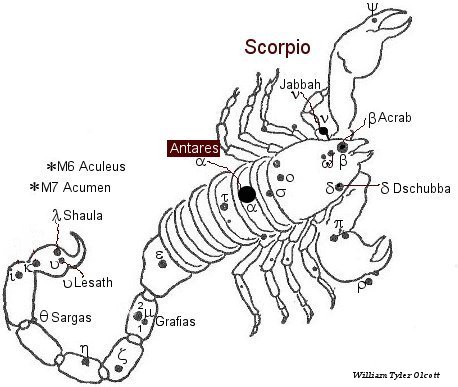 Alpha (α) Scorpius, Antares, is a red binary star, fiery red and emerald green, near the center of the constellation Scorpius and was sometimes called "the Heart of the Scorpion". Alpha (α) Scorpius, Antares, is a red binary star, fiery red and emerald green, near the center of the constellation Scorpius and was sometimes called "the Heart of the Scorpion".
Antares, the well-nigh universal title for this splendid star, is transcribed from the second-century Greek astronomer Ptolemy's (Greek) Antares in the Syntaxis, and generally thought to be from {p.365} anti Ares, "similar to," or the "rival of," Mars, in reference to its color, — the Latin Tetrabiblos had Marti comparatur; or, in the Homeric signification of the words, the "equivalent of Mars," either from the color-resemblance of the star to the latter, or because the astrologers considered the Scorpion the House of that planet and that god its guardian. Thus it naturally followed the character of its constellation,— perhaps originated it,— and was always associated with eminence and activity in mankind.
Dutch scholar Grotius (1583-1645), however, said that the word Antares signifies a Bat, which, as Vespertilio, Greek tragic poet Sophocles (496?-406 B.C.) perhaps called it; but the 17th century German astronomer Bayer erroneously quoted from Hesychios (5th century. AD.) (Greek) Antartes, a Rebel, and Tyrannus. The 17th century Dutch astronomer Caesius appropriately styled the constellation Insidiata, the Lurking One.
Others say that it was Antar's Star,— but they forget the second-century Greek astronomer Ptolemy,—the celebrated Antar or Antarah [Antarah] who, just previous to the time of Muhammad, was the mulatto warrior-hero of one of the Golden Mu'allakat. [Muallaqat. Allen notes: These were the famous seven selected poems of Arabia, said to have been inscribed in letters of gold on silk, or Egyptian linen, and suspended, as their title signifies, in the Kabah at Mecca.]
Our word, however, is sometimes written Antar, which Beigel said is the Arabic equivalent of "Shone"; but the Latin translator of the 1515 Almagest connected it with Natar, Rapine, and so possibly explaining the generally unintelligible expression tendit ad rapinam applied to Antares in that work and in the Alfonsine Tables of 1521; or the expression here may refer to the character of Ares, the god of war. The Rudolphine Tables designated it as rutilans, Pliny's (23-79 A.D.) word for "glowing redly."
The Arabians' Kalb al Akrab, the Scorpion's Heart, which probably preceded the Kardia Skorpion and Cor Scorpii of Greece and Rome respectively, became, in early English and Continental lists, Kelbalacrab, Calbalacrab, Calbolacrabi, Calbalatrab, and Cabalatrab; the Italian astronomer Riccioli (1598-1671) having the unique Alcantub, although he generally wrote Kalb Aakrab.
This star Antares (α Scorpius) alone constituted the 16th manzil (Arabic Moon Mansion), Al Kalb, the Heart, one of the fortunate stations.
But the Chinese included sigma (σ) and tau (τ), on either side of Antares, for their sieu (Chinese Moon Mansion), the synonymous Sin, anciently Sam, sigma (σ) being the determinant; although Brown says that this Heart refers to that of Tsing Lung, the Azure Dragon, one of the four great divisions of their zodiac. They also have a record of a comet 531 B.C., "to the left of Ta Shin," which last Williams identified with Antares; while, as the Fire Star, Who Sing, it seems to have been invoked in worship centuries before our era for protection against fire. With some adjacent it was one of the Ming t'ang, or Emperor's Council-hall; his sons and courtiers, other stars, standing close by, to whom Antares, as Ta Who, announced the principles of his government.
{p.366} The Hindus used alpha (α Antares), sigma (σ), and tau (τ) for their nakshatra (Hindu Moon Mansion) Jyestha, Oldest, also known as Rohini, Ruddy, from the color of Antares, — Indra, the sky-goddess, being regent of the asterism that was figured as a pendent Ear Jewel.
It was one of the four Royal Stars of Persia, 3000 B.C., and probably the Guardian of the Heavens that Dupuis mentioned as Satevis; but, as their lunar asterism, it was Gel, the Red; the Sogdians (an Iranian people) changing this to Maghan sadwis, the Great One saffron-colored. The Khorasmians (east of Persia) called it Dharind, the Seizer; and the Copts (who are now the Christians in Egypt), Kharthian, the Heart.
It pointed out to the Babylonians their 24th ecliptic constellation, Hurru, of uncertain meaning, itself being Urbat according to an astrolabe discovered in the palace of Sennacherib and interpreted by the late George Smith; Brown, however, assigns this title to stars in Lupus (Lupus adjoins Scorpius). Other Euphratean names were Bilu-sha-ziri, the Lord of the Seed; Kak-shisa, the Creator of Prosperity, according to German Orientalist Peter Jensen (1861-1936), although this is generally ascribed to Sirius; and, in the lunar zodiac, Dar Lugal, the King, identified with the god of lightning, Lugal Tudda, the Lusty King. Naturally the inscriptions make much of it in connection with the planet Mars, their UI Suru, showing that its Arean association evidently had very early origin; and from them we read Masu (?) Sar, the Hero and the King, and Kakkab Bir, the Vermilion Star. Brown identifies it with the seventh antediluvian king, (the Greek word) Euedoranchos, or Udda-an-χu, the Day-heaven-bird.
In Egyptian astronomy it represented the goddess Selkit, Selk-t, or Serk-t, heralding the sunrise through her temples at the autumnal equinox about 3700-3500 B.C., and was the symbol of Isis in the pyramid ceremonials (Isis, perhaps the Moon, is identified with a number of stars). Renouf included it with Arcturus in the immense figure Menat.
[Star Names, Their Lore and Meaning, Richard Hinckley Allen, 1889].
This is one of the four key stars in the heavens, also called archangel stars. Michael (Aldebaran) watcher of the East. Gabriel (Fomalhaut) watcher of the South. Raphael (Regulus) Watcher of the North. Oriel (Antares) Watcher of the West. At one time they marked the two Equinoxes and two Solstices. Aldebaran marked the zero Aries point in 3044 BC, Antares marked zero Libra 3052 BC, Fomalhaut marked zero Capricorn, 2582 BC, Regulus marked zero Cancer 2345 BC. As one of the four Royal stars of Persia its name was Satevis; but, as their lunar asterism, it was Gel, the "Red" the Sogdians changing this to Maghan sadwis, the "Great One" saffron-colored. [The angel associations come from Eric Morse, The Living Stars, p.35. Allen's explanation of these four stars on page 256 of Star Names]
These four stars have been characterized as Horses, reflected both in the famed Four Horsemen of Apocalypse (Revelations 6) and Chariot Horses in the Book of Zechariah. [Dr Eric Morse, The Living Stars, p.56.]
Antares as Antar's Star, Antarah or Ántara
Allen (Star Names, p.365) says "Others say that Antares was Antar's Star, and referring to the celebrated Arabic hero Antar, or Antarah".
This refers to Ántara who portrays the "Heart of the Scorpion" as in the Manilius' representation of the Scorpion character. "By virtue of its tail armed with its powerful sting, the Scorpion creates natures ardent for war and active service, which rejoices in plenteous bloodshed and in carnage more than in plunder".
The hero Ántara lived just previous to the time of Muhammad; he died 615 AD at age 90; and was the mulatto warrior-hero of one of the Golden Mu'allakat. Son of an African slave woman and an Arab sheikh, Ántara was the bravest warrior of all of the Arabs. As a lowly slave himself he was spurred to greatness by love for his noble cousin 'Abla. He had his chance when the fortunes of war turned against the tribe. With the enemy closing in on their encampment, his father called him to battle. He followed the call and soon proved himself the most valiant warrior in Arabia. In doing so he held his family to the ancient rule that only a free man with full rights may join in battle. The rule freed him of the taint of slavery and entitled him to marry his beloved. He was a poet of the first rank; his most eloquent poem can be seen on this website page; "Ántara's Ode," where he tells 'Abla and the world of his love for her and of the victories that made him worthy of her hand.
The Lunar Mansions
Antares (α Scorpius) alone constituted the 16th manzil, Arabic Moon Mansion, Al Kalb, the Heart, one of the fortunate stations.
Influences the 16th Arabic Moon Mansion Al Kalb: Causes discord, sedition, conspiracy against princes and rulers, and revenge from enemies, but frees captives and helps building.
With Moon transiting here: sow seeds, travel and go to war. [Robson*, p.73.]
The Hindus used alpha (α Antares), sigma (σ), and tau (τ) for their 16th nakshatra (Hindu Moon Mansion) Jyestha, Oldest, also known as Rohini, Ruddy, from the color of Antares, — Indra, the sky-goddess, being regent of the asterism that was figured as a pendent Ear Jewel.
Influences of the 16th Hindu Moon Mansion Jyestha: Ruled by Mercury. A sharp asterism belonging to the serving caste and favorable for punishment, torture, imprisonment, exorcism, mesmerism and separation or union when containing the Moon. Those born on the lunar day will be valiant, wealthy, famous, well born, somewhat dishonest, fond of travelling and in a high position. With Moon here at birth native will be cheerful, irascible, charitable, but will have few friends. Rules deserts and the right side of the body. [Robson*, p.82.]
The astrological influences of the constellation Scorpius
Ptolemy makes the following observations: "The bright stars in the front of the body of Scorpio have an effect similar to that produced by the influence of Mars, and partly to that produced by Saturn: the three in the body itself . . . are similar to Mars and moderately to Jupiter: those in the joints of the tail are like Saturn and partly like Venus: those in the sting, like Mercury and Mars." By the Kabalists Scorpio is associated with the Hebrew letter Oin and the 16th Tarot Trump "The Lightning-Struck Tower." [Robson*, p.60-61.]
The astrological influences of the constellation Scorpius given by Manilius:
"The Scorpion presides over arms" [Manilius, Astronomica, 1st century AD, book 4, p.253]
"By virtue of his tail armed with its powerful sting, wherewith, when conducting the Sun's chariot through his sign, he cleaves the soil and sows seed in the furrow, the Scorpion creates natures ardent for war and active service, and a spirit which rejoices in plenteous bloodshed and in carnage more than in plunder. Why, these men spend even peace under arms; they fill the glades and scour the woods; they wage fierce warfare now against man, now against beast, and now they sell their persons to provide the spectacle of death and to perish in the arena, when, warfare in abeyance, they each find themselves foes to attack. There are those, too, who enjoy mock-fights and jousts in arms (such is their love of fighting) and devote their leisure to the study of war and every pursuit which arises from the art of war." [Manilius, Astronomica, 1st century AD, p.239-240].
The astrological influences of the star Antares
According to Ptolemy it is of the nature of Mars and Jupiter. Alvidas gives Jupiter sextile Venus, but this is unlikely considering the decidedly martial and malefic nature of the star. It causes malevolence, destructiveness, liberality, broad-mindedness, evil presages and danger of fatality and makes its natives rash, ravenous, headstrong and destructive to themselves by their own obstinacy. [Robson*, 136.]
A Mars nature, in which the powers of Mercury and Jupiter and Saturn are also added. Antares makes people tough, belligerent and pugnacious. This is an important star for military personnel and is said to convey mental alertness, strategic ability and courage and to make dare-devils, especially if tied up with the MC, Ascendant, Sun or Jupiter. If associated with Mars, courage is said to become foolhardiness, leading to increased dangers. Natives with this particular configuration have to be prepared at all times for sudden incidents, unforeseen events and potential accidents. According to tradition, Antares is of violent character and is credited with being significant for a violent death, either in battle or by process of law. On the other hand, danger may come about by fire, weapons or machinery. Antares is also said to be unfortunate for the eyes, if in conjunction with the Ascendant, Moon or Sun and this has proven to be the case by later researchers. [Fixed Stars and Their Interpretation, Elsbeth Ebertin, 1928, p.70-71.]
If Rising: Riches and honor, violence, sickness, benefits seldom last. [Robson*, p.137.]
If culminating: Honor, preferment and good fortune. [Robson*, p.137.]
With Fortuna or its dispositor, poverty. [Robson*, p.137.]
With Sun: Pretended religion, insincere, honor and riches ending in disgrace and ruin, military preferment, danger of treachery, violence committed or suffered, fevers and sickness, injuries to the right eye, violent death. If rising or culminating, great honor through violence attended by difficulties and casualties. If with Mars also, pestilential disease. [Robson*, p.137.]
With Moon: Popular, broad-minded, interested in philosophy, science and metaphysics, liable to change religious opinions, influential friends, favorable for business and domestic matters, active in local affairs, great power, honor and wealth but benefits may not prove lasting, danger of violence, sickness, drowning or assassination. If in 1st or 10th houses, honor and preferment but many dangers and calamities. Liable to blindness or eye injuries especially if at the same time Mars or Saturn be with Regulus. If Saturn be with Aldebaran, danger of a violent death probably by hanging; but if Mars be with Aldebaran death by a stab, blow or fall especially if in angles. If a malefic be with Aldebaran in the 4th, 7th, 11th or 12th houses, death by a sudden sword-thrust, stab or fall (operations can be substituted for stabs nowadays). [Robson*, p.137.]
With Mercury: Suspicious, wrongfully accuses friends, unpopular, uses ecclesiastic influence in business, money obtained slowly and with much difficulty, danger of sickness to the native and his family, and death of a relative at home or away. [Robson*, p.138.]
With Venus: Insincere, dishonest, energetic and able but selfish. [Robson*, p.138.]
With Mars: Detrimental habits powerfully affecting the life, quarrels with friends and relatives, fairly favorable for gain. If at the same time the Moon is with Aldebaran, danger of death by sword or hanging. [Robson*, p.138.]
With Jupiter: Great religious zeal real or pretended, ecclesiastical preferment, tendency to hypocrisy, benefits through relatives. [Robson*, p.138.]
With Saturn: Materialistic, dishonest through circumstances created by environment, religious hypocrisy, many disappointments, loss through quarrels and legal affairs, trouble through enemies, many failures, hampered by relatives, unfavorable for domestic matters, much sickness to and sorrow from children. If at the same time the Moon is with Aldebaran, danger of death by sword or hanging. [Robson*, p.138.]
With Uranus: Abnormal and extreme ideas, hypocritical, lies and exaggerates, extremely socialistic, incites to riot, lawlessness and anarchism and in danger of imprisonment on this account, occasional poverty, disharmony with relatives, more than one marriage, unfavorable for children, violent death. [Robson*, p.138.]
With Neptune: Shrewd, cunning, unbalanced and mentally unsound, secretive but apparently candid, dishonest, tendency to theft, economical, untruthful, strange religious ideas, evil environment, gain through hard work, sudden and unexpected death brought about by treachery or through enemies who will escape retribution. [Robson*, p.138.]
|
|
|
|
|
Eze 1:1 - 1:19
As I looked, behold, a storm wind was coming from the north, a great cloud with fire flashing forth continually and a bright light around it, and in its midst something like glowing metal in the midst of the fire. Within it there were figures resembling four living beings .
And this was their appearance: they had human form. Each of them had four faces and four wings. Their legs were straight and their feet were like a calf's hoof, and they gleamed like burnished bronze.[...] As for the form of their faces, had the face of a man; all four had the face of a lion on the right and the face of a bull on the left, and all four had the face of an eagle.
Such were their faces. Their wings were spread out above; each had two touching another and two covering their bodies And each went straight forward; wherever the spirit was about to go, they would go, without turning as they went. In the midst of the living beings there was something that looked like burning coals of fire, like torches darting back and forth among the living beings . The fire was bright,and lightning was flashing from the fire. And the living beings ran to and fro like bolts of lightning.
Now as I looked at the living beings ,behold, there was one wheel on the earth beside the living beings , for the four of them.The appearance of the wheels and their workmanship like sparkling beryl, and all four of them had the same form, their appearance and workmanship as if one wheel were within another. Whenever they moved, they moved in any of their four directions[...]
Please view the following books for further info:
Witness of the Stars by E.W. Bullinger
The Gospel in the Stars by Joseph Seiss
Virgo, is depicted as a virgin in every ancient reference, holding in one hand abranch, and in the other a sheaf of grain, or seed, always associated with a child, "Shesh nu" in Egyptian, the desired son, the symbol of the incarnationof God on earth.
Libra, the scales or in the earliest zodiacs, an altar. Its meaning is the measuring of a price. One of its stars in Arabic means, "the price which is deficient",while opposite is a star whose name means, "the price which covers," or atonement. Libra symbolizes the price of the conflict, the deficient works of man compared to the perfect and finished sacrifice of Jesus accomplished on the cross.
Scorpio,with his claws reaching out to influence the scales, is crushed beneath the foot of Ophiuchus, the serpent holder, who in earliest times was depicted as an eagle. Ophiuchus 's foot is stung (wounded foot, like Oedipus) by the upraised tail of the scorpion, his other foot is above the scorpion's heart. He restrains the serpent coiled around him from taking a crown.Ophiuchus depicts the earliest prophecy in the Bible, "I will put enmity between the serpent and the offspring of the woman, it will strike at his heel, and he will crush (the serpent's) head."
Sagittarius,in the oldest pictures of the zodiac is a cherubim. This symbol is situated 1/3 rd of the way around the zodiacal circle. It had the body of both lionand bull with wings of an eagle and the head of a woman. Sagittarius is the symbol of the incarnation, both God and man, animals representing the four corners of the heavens and symbolizing the aspects of God's redemptive work on this earth, he is poised with his arrow drawn and pointed at theheart of the scorpion. Underneath him is the southern cross.
Capricorn, the goat with the tail of the fish. To the Hebrews, the goat was the sin offering, Capricorn is posed with his foot under him and his head bowed,as if in death. The second half of this symbol is the tail of a fish, the most prolific creature in nature, the fish lives in the waters, symbol of life and God's spirit. Out of the son of God's death, comes everlasting life.
Aquarius,the water bearer, the one pouring out life giving waters that symbolize God's spirit, into the mouth of the fish.
Pisces, the fishes connected to the neck of the sea monster, one points to the center of heaven the other follows the ecliptic, the path of the earth around the sun. "Thy kingdom come, thy will be done on earth as it is in heaven."
Aries, the lamb prepared from the foundations of the world, the unblemished sacrifice for mankind. with his foot poised to strike off the tether attaching the fishes to the neck of the sea monster. "He (Jesus Christ), came to set the captives free".
Taurus, the Bull. His horns, symbolizing God's judgment, are pointed to the earth,one stabs the heal of a shepherd "Aquilla", who holds his flock, Christ the good shepherd, received in our place God's absolute judgment. In the bull's neck is the Pleiades, the congregating of the judges, who come back to earth after their resurrection to judge the earth with Christ at his second coming.
Gemini, the twins. Castor is the suffering redeemer, and Pollux is the king. Symbols of the first and second coming of Christ.
Cancer, the crab. Originally it was the fortress, the impregnable enclosure of protection.In Egypt it was a scarab, the beetle that hatched from the ground and flew to heaven, the stronghold of the saved.
Leo, the great lion. "The conquering lion of Judah", Jesus Christ, who will come again. The king that the apostle John traced back to that tribe of Israel. In his heart is the star called Regulus.
This is the whole story of God's atonement work on earth, its beginning and ending are symbolized by the sphinx - combining Virgo and Leo.
-
At this point it will be helpful to understand some basic principles of the meaning of numbers in scripture. With insight into the symbolic meaning that numbers possesas they occur in the Bible one will understand the full meaning of the "riddle of the sphinx" The study of the meaning of numbers in scripture is called Biblical Numerics or Biblical Numerology. This study is intrinsicto theology and history of the Bible because of the language it was written in, Hebrew and Greek. These two languages share the aspect of using letters for words and also a system for counting. The spiritual meaning for numbers that continuously show up in scripture, intentionally put there by God,can be discerned. The following list is a brief description of the symbolic meaning of primary numbers.
One: symbol of unity, primacy and beginning, in all languages.
Two: first number that can be divided from itself, it symbolizes division or difference.
Three: Divine perfection. Trinity. 3 also refers to the necessary dimensions for physicality.
Four: The number of Creation, the 3 of God plus the 1, a new beginning.
Five: 4+1, Creation plus a New Beginning. 5 = grace or favor.
Six: The number of imperfection, the number of man. Creation plus division 4+2.
Seven: Completion. The number of spiritual perfection. Creation was completed, God rested on the7th day.
Eight: is the number of resurrection 7+1 completion plus newness.
Nine: Symbol of judgment. Akin to the number 6, 3x3=9 and 3+3=6, it can refer to the End.
Ten: Symbolizes completeness of order -- after 10 the numbers repeat.
Eleven: The subversion and undoing of 10 - a flawed addition to that perfect order.
Twelve: is the symbol of governmental perfection or rule 3x4 -- God's rule over His creation.
The Greek myth Oedipus Rex contains revealing symbology -- too much to address in this article. But for our purposes, let's examine the riddle of the sphinx. The monsterous Sphinx asked Oedipus: "What speaks with one voice, yet in the morning walks on four legs, walks at noon on two legs and in the evening walks on three legs?" Upon hearing the correct answer, the Sphinx left her lofty perch and fell to the rocks below. The symbolism alludes to the true identity of the sphinx as a rebellious cherub -- perched in the mountainous high places -- literally amongst the stones -- outsideThebes, the City of Light. The man who defeats this rebellious cherub will have a messianic name, Oedipus, literally wounded in the foot. The man who was named Wounded Foot, upon defeating the rebel cherub, redeems his promised bride at the end of Oedipus Rex, taking his place as king.
The sphinx or wrathful cherub, asked the question, "What speaks with one voice, yet walks on four feet in the morning, two feet at noon and three feet in the evening?" The question decoded using Bible numerics, would read: "What creature, spoken into creation by God, (one) walked before God in perfection at the beginning, (four) fell from grace and was divided from God, (two) and will be redeemed and made perfect by God, (three)?
The answer: man.The real question couched ingeniously in the riddle was this, who will redeem man?
The earliest prophecy in the Bible concerning the messiah who will defeat the serpent, or the rebel cherub is in Genesis 3:15. Oedipus the Wounded Foot is symbolicof the coming Messiah, who would be born of the lineage of Adam and Eve. The defeater of the Greek Sphinx -- the defeater of death -- would speak the answer and the cherub would be destroyed. That is, The Word is Wounded Foot's weapon, and the means by which the bride, and all of the land, would be redeemed.
"From now on, you and the woman will be enemies, and your
offspring and her offspring will be enemies. He will crush
your head, and you will strike his heel." Genesis 3:15
 According to Menzel, author of A Field Guide to the Stars , "Ophiuchus, the Serpent Bearer, may well be an alternative form of Hercules, for the giant frequently had to deal with snakes, beginning in infancy when he strangled the serpentin his crib. Ophiuchus bears Serpens, the Serpent, in his hands, and his right foot is almost touching the stinger of the Scorpion". The offspring of Adam & Eve, the prophesied Messiah, "Bears the Serpent" as a representation of sin, and redeems all man through his crucifixion and resurrection. Ophiuchusis the resurrected Asclepius [also, Esculapius ], the healer whose symbolis the serpent staff. The learned Greek hero Asclepius was killed because he was able to raise the dead. Here is a brief but illuminating account: According to Menzel, author of A Field Guide to the Stars , "Ophiuchus, the Serpent Bearer, may well be an alternative form of Hercules, for the giant frequently had to deal with snakes, beginning in infancy when he strangled the serpentin his crib. Ophiuchus bears Serpens, the Serpent, in his hands, and his right foot is almost touching the stinger of the Scorpion". The offspring of Adam & Eve, the prophesied Messiah, "Bears the Serpent" as a representation of sin, and redeems all man through his crucifixion and resurrection. Ophiuchusis the resurrected Asclepius [also, Esculapius ], the healer whose symbolis the serpent staff. The learned Greek hero Asclepius was killed because he was able to raise the dead. Here is a brief but illuminating account:
Orion (the blinded demigod who had regained his eyesight) journeyed to the island of Crete. There he met the beautiful Artemis, goddess of the Moon, also called Kynthiabecause she and her twin brother, Apollo, were born on Mount Kynthos. Apollo disapproved of the union between his sister the Moon Goddess and Orion. His sister was so involved with Orion that she forgot to carry the Moon across the sky. Apollo was disgusted with his sister and thought the only way to solve this problem was to kill Orion.
One day Apollo sent Orion to the sea to catch some fish. When Orion waded through the sea,his head just above water, Apollo called his sister and pointed out the unrecognizable black dot far away. He tauntingly told her that although she was good with her bow, even she had her limits, and it was highly unlikely that she could hit the tiny target. Artemis felt insulted, immediately fit an arrow to her bow, and shot the target. Her aim was perfect, as always.The arrow pierced Orion's head, killing him instantly. Artemis was horrified to discover her mistake. She took Orion's body to her nephew Esculapius (son of Apollo & Coronis), begging him to resurrect Orion. Before Esculapius could act, a thunderbolt from Zeus destroyed Orion's body, but killed Esculapius as well. Artemis the Moon Goddess set Orion in the heavens, and Zues, realizing that Apollo's son Esculapius didn't deserve his fate, set him in the stars as the constellation Ophiuchus.
Another reference to the man who is victorious over one the many manifestations of the rebel cherub is found in the typology of Orion. According to Bullinger's The Witness of the Stars: His name is given as Ha-ga-t, which means thisis he who triumphs. The hieroglyphic characters below read Oar. Orion was anciently spelt Oarion, from the Hebrew root, which means light. So that Orion means coming forth as light. The ancient Akkadian was Ur-ana,the light of heaven.
The constellationis mentioned by name, as being perfectly well known both by name and appearance, in the time of Job; and as being an object of familiar knowledge at that early period of the world's history. See Job 9:9; 38:31, and Amos 5:8 (Heb.Chesil, which means a strong one, a hero, or giant).
 The picture presents us with "the Light of the world." His left foot is significantly placed upon the head of the enemy. He is girded with a glorious girdle,studded with three brilliant stars; and upon this girdle is hung a sharp sword. Its handle proves that this mighty Prince is come forth in a new character. He is again proved to be "the Lamb that was slain," for the hilt of this sword is in the form of the head and body of a lamb. In hisright hand he lifts on high his mighty club; while in his left he holds forth the token of his victory -- the head and skin of the "roaring lion" [ww - he has been victorious over the rebel cherub/sphinx] We ask in wonder,"Who is this?" and the names of the stars give us the answer. The picture presents us with "the Light of the world." His left foot is significantly placed upon the head of the enemy. He is girded with a glorious girdle,studded with three brilliant stars; and upon this girdle is hung a sharp sword. Its handle proves that this mighty Prince is come forth in a new character. He is again proved to be "the Lamb that was slain," for the hilt of this sword is in the form of the head and body of a lamb. In hisright hand he lifts on high his mighty club; while in his left he holds forth the token of his victory -- the head and skin of the "roaring lion" [ww - he has been victorious over the rebel cherub/sphinx] We ask in wonder,"Who is this?" and the names of the stars give us the answer.
The brightest, a(in the right shoulder), is named Betelgeuz, which means the coming (Mal 3:2) of the branch.
The next, b (in theleft foot), is named Rigel, or Rigol, which means the foot that crusheth.The foot is lifted up, and placed immediately over the head of the enemy,as though in the very act of crushing it. Thus, the name of the star bespeaks the act.
The next star, g (in the left shoulder), is called Bellatrix, which means quickly coming,or swiftly destroying.
The name of the fourth star, d (one of the three in the belt), carries us back to the old, old story, that this glorious One was once humbled; that His heel was once bruised. Its name is Al Nitak, the wounded One. * Similarly the star k (in the right leg) is called Saiph, bruised, which is the very word usedin Genesis 3:15, thus connecting Orion with the primeval prophecy. LikeOphiuchus, he has one leg bruised; while, with the other, he is crushing the enemy under foot.
It is no mere coincidence that the constellations and star names echo the messianic prophecy of the "man" with the wounded foot, who crushes the enemy.
And it is also no surprise that the narrative in the heavens would be twisted by those cherubs who, pre-rebellion, were present at the creation of the heavens.
Job 38:1-7
Then the LORD answered Job out of the whirlwind and said ... "Where were you when
I laid the foundation of the earth ? ... When the morning stars sang together And
all the sons of God shouted for joy ?
The Bible describes a history of our solar system, and the ancient non-human occupants of the solar system. Popular culture seems to be obsessed with the ancient mysteries of the Pyramid and Sphinx of Giza, and at the same time, futuristic science fiction scenarios like those in Star Trek, Close Encounters etc. Recently, CNN featured photos of what seems to be a sphinx-face on Mars. NASA scientists have confirmed that Mars was once a more habitable planet, and legions of fans of the X-Files are convinced that the Truth is Out There -- the truth that there is life on other planets. Or perhaps the truth that is being discovered by researchers like Hancock and Hoagland -- that some other civilization of scientists and builders came before us, and as Hoagland suggests, "we are the Martians".
If there proves to be a giant Sphinx Face on Mars, the identity of these monument builders should not be a mystery: Genesis 6:4 These non-human builders populate the Bible, and are the progenitors of those beings of myth and legend, demi-gods, heroes and men of name.
The typology of the Martian Sphinx confirms that its construction is of angelic origin.
The Sphinx face on Mars unites Virgo and Leo, the human face and that of a lion.
|
|
|
|
|
|
GOLDEN GATE/PUERTA DE ORO-RELACION DE FATIMA CON EL NUMERO 47
| grail in Simple Gematria Equals: 47 |
( |
g
7 |
r
18 |
a
1 |
i
9 |
l
12 |
) |
| grail in Simple Gematria Equals: 47 |
( |
g
7 |
r
18 |
a
1 |
i
9 |
l
12 |
) |
| raquel in Simple Gematria Equals: 74 |
( |
r
18 |
a
1 |
q
17 |
u
21 |
e
5 |
l
12 |
) |
| john in Simple Gematria Equals: 47 |
( |
j
10 |
o
15 |
h
8 |
n
14 |
) |
| jesus in Simple Gematria Equals: 74 |
( |
j
10 |
e
5 |
s
19 |
u
21 |
s
19 |
) |
| giza in Simple Gematria Equals: 43 |
( |
g
7 |
i
9 |
z
26 |
a
1 |
) |
| mark in Simple Gematria Equals: 43 |
( |
m
13 |
a
1 |
r
18 |
k
11 |
) |
| gize in Simple Gematria Equals: 47 |
( |
g
7 |
i
9 |
z
26 |
e
5 |
) |
| john in Simple Gematria Equals: 47 |
( |
j
10 |
o
15 |
h
8 |
n
14 |
) |
These are the four creatures of Ezekiel 1:10 and Revelation 4:7 which also relate to the four Apostles, the seasons, the elements and the guardians of the four directions.
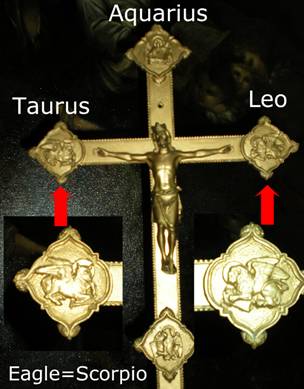
‘True Cross’ Cathedral Lisieux, France 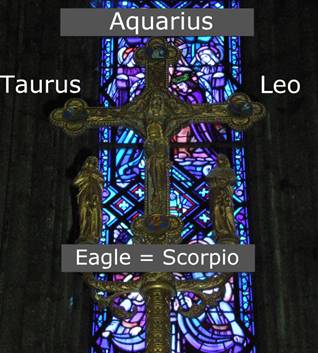
‘True Cross’, Baselique Notre Dame d’Ouvres La Delivrande, France
In churches, the four signs of the Zodiac often reoccur and are associated with ‘Judgment Day’ and the ‘End of Times’
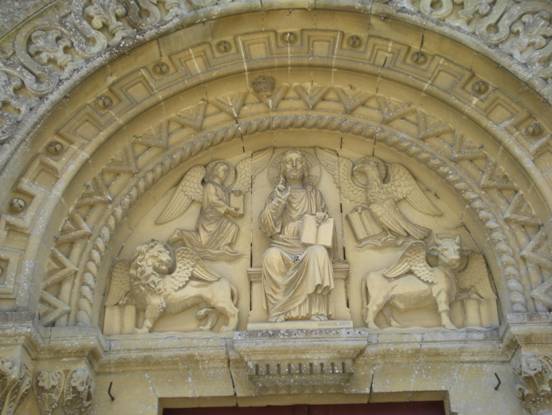
Jesus portrayed at the Last Judgment can often be found in the Tympanium above the entrance of churches and cathedrals. Notice, the lion (Leo) on the left, the bull on the right (Taurus), the angel on the left (Aquarius) and the eagle on the right ( Scorpio).
The four evangelists Luke, John, Mathew and Mark likewise have been associated with these four Zodiac signs as well:
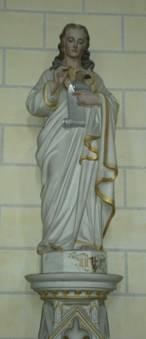 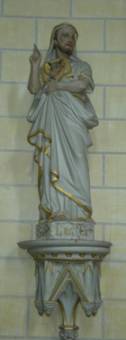 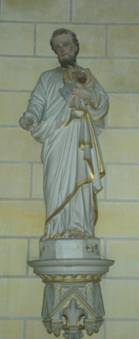 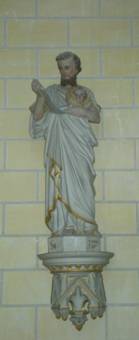
Mark = Scropio (Eagle), Luke = Taurus, John = Leo, Matthew = Aquarius
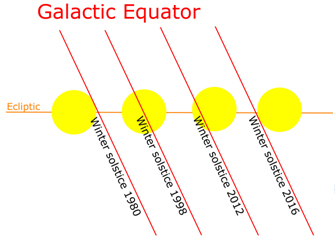 |
|
Winter Solstice Galactic Alignment of the Sun with the Galactic Equator
|
On Earth, the River Nile was the reflection of this great river in the sky, in accordance with the Hermetic principle "as above, so below." Herschel's earliest ingenious research has demonstrated that all of the pyramids along the river Nile represent constellations along the Milky Way, not just Orion! There are more than 50 pyramids in total, and their true meaning can only be deciphered when one considers the whole of Egypt.
During a Great Celestial Conjunction, the Sun crosses that great river in the sky, the Milky Way. Egyptologists explain that the solar God Ra (and Horus) required a boat because they sailed the Heavens from sunrise in the East to sunset in the West. At night, Ra travelled the Netherworld to be reborn in the morning at sunrise. Egyptologists reject the idea that the Egyptians understood the Precession of the Equinoxes and that the Sun also sojourns along the zodiac in a 26,000 year journey corresponding with the Precession Cycle.
In the Book of the Gates, the travel of the Sun at night along with the deceased pharaoh into the Netherworld is described. The Sun enters the Netherworld in the first hour just after sunset to be reborn in the morning at sunrise after a twelve hour nocturnal journey. There are many parallels, however, with the precessional journey of the Sun along the twelve signs of the zodiac to be discovered in the Book of the Gates. The 12 hours in the Book of Gates are structured into four groups of three hours, denoting a cross in the face of the clock. In the 12th hour Nun raises the solar barque with the scarab beetle of the Sun God from the primeval waters (Milky Way?), this is the hour of the rebirth of the Sun.
|
|
Left: Nun raises the solar barque from the primeval waters at ‘sunrise’, the time of the rebirth of the Sun.
|
During Ra's travel through all of the twelve signs of the zodiac in the precession cycle, he will be requiring a boat to twice cross that great river in the sky, the Milky Way! It is probably the only reason why the Egyptian deities required a Sun barque in the first place. Boats are used to cross waters, not skies, so it was used not for their nightly ecliptic travel from East to West through the Netherworld, but for their travels along the zodiac in the precession cycle. It is during this journey that the Sun would be required to cross the waters of the Milky Way at least twice. The Book of the Gates may therefore have been misinterpreted by Egyptologists as the nocturnal journey of the Sun simply because they reject the idea that the Egyptians understood Precession! Keep in mind that only twice per year on the equinox the day and night will be exactly 12 hours in length. It is therefore far more logical that the 12 hours in the Book of the Gates are in fact the 12 zodiacal Ages of the Precession Cycle.
Pharaohs in ancient Egypt were buried with their arms crossed holding Ankhs in their hands. This posture of the deceased pharaoh can be found on sarcophagus and in statues throughout Egypt. The Ankh represents a cross symbol.
|
|
Left: Grave statue of Tjel mayor of Memphis under Amenhotep III Dutch national museum of antiquities, Leiden.
Right: Sarcophagus with crossed arms and X cross on chest, Dutch National Museum of antiquities, Leiden.
|
Since the Greek inherited much of their wisdom from the Egyptians, it's more than reasonable to suspect that the gate or portal mentioned in the Book of the Gates through which the pharaoh enters the Netherworld is, in fact, the Gate of God that the Greek writer Macrobius writes about. The Gate of God was also called the Golden Gate, while the Gate of Men was called the Silver Gate. The very same Egyptian cross symbolism used by the pharaohs associated with the Golden and Silver gates of the soul (and the Sun) can still be recognized in the coat of arms of the Vatican, consisting of two crossed keys; one Golden, one Silver.
|
|
Silver and Golden cross in the Coat of Arms of the Vatican
|
The Golden Gate is the ecliptic Milky Way crossing at the Scorpio-Sagittarius nexus on the zodiac while the Silver Gate is the Milky Way ecliptic crossing at the Gemini-Taurus nexus. The Silver Gate was represented by the horns of Isis and the associated bull Taurus.
The Silver Gate is also clearly depicted in the Narmer Palette (3100 BC) named after the Egyptian pharaoh. The Narmer Palette shows the celestial goddess bull Bat (Taurus) with her horns bent over pointing exactly to the place of the rebirth of the Sun, the Silver Gate. The two cow's heads on top of the palette also represent Bat. In-between the two cow goddesses a hieroglyph is depicted representing the rising of the Sun in between two mountains on the horizon. It's a hieroglyph that is very similar to the Akhet hieroglyph with the same significance.
|
|
Bat on the left and right with the 'Akhet' glyph in between.
Dutch national museum of antiquities, Leiden
|
Bat was the goddess of the Milky Way considered to be a pool of Bat's cow milk. Bat was also the goddess of the human soul, the "Ba" that incarnated into human life form. Since the soul incarnated into human life passing through the Silver Gate (crossing of Milky Way and ecliptic), it's not surprising that Bat was both the goddess of the Milky Way and the human soul. Ba is a derivative of Bat, whereas "Ka" represents the human light-body. "Mer" represents the light of the Egyptian light-body-soul complex, the "Mer-Ka-Ba." Bat was also called the "Ba of Two Faces." Egyptologists are in the dark about her name and don't seem to understand that she was called this way, because there are actually two portals both to and from the Netherworld for the Ba to descend into the physical plane (Silver Gate) and ascend from the physical plane (Golden Gate). Both Hathor, Isis and Bat are all cow goddesses and Egyptologists have often pointed out the similarities between these goddesses depicted with cow-horns suspecting that they may have the same origins...they all represent the Silver Gate.
At the bottom of the Narmar palette in-between the horns of the bull, the very same hieroglyph is depicted as the one shown between two Bat bulls on top of the palette. This Akhet-like hieroglyph symbolises the rising Sun on the horizon.
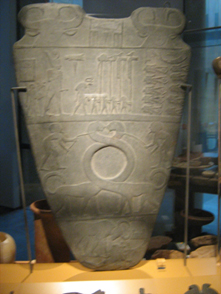 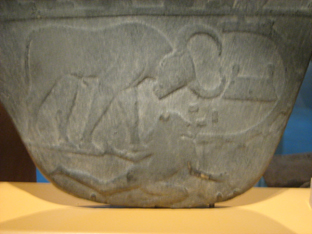 |
The Narmar Palette, bull in close up on the right. The bull is leaning towards the Silver Gate near the Gemini-Taurus nexus depicted in between the horns. The hieroglyph in between the horns resembles an Akhet glyph and represents the Silver Gate.
Dutch national museum of antiquities, Leiden
|
On the other side of the Narmer palette two identical men, hence suggesting twins are depicted. They are both looking over their shoulders to a particular square over the left man’s shoulder. We surmise that the twins represent Gemini which would make sense since the actual ecliptic Milky Way crossing of the Silver Gate occurs in 5° Gemini (sidereal zodiac) and the square could therefore be suggesting the Silver Gate.
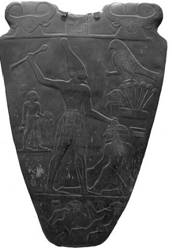 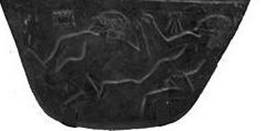
Narmer palette backside
Dutch national museum of antiquities, Leiden
The author Audrey of the website "Ancient Egypt" writes while referring to the Narmar Palette: "They present an overview of the astronomical event which occurred on September 21st in 4468BCE, when the Autumn (Fall) Equinox of the Sun was in conjunction with the Milky Way."
At the Autumnal Equinox, the Sun was indeed at the Milky Way, however at the Golden Gate. At the Vernal Equinox of 4468 BC, the Sun resided at the Silver Gate. The author (Audrey) does not seem to realise that this moment represented a Great Celestial Conjunction when the equinox axis (Vernal and Fall) aligned with the Galactic Equator and the Sun resided at the Gates of the Gods.
Instead, while interpreting the hieroglyphs of the 10 decapitated figures near the Solar Barque, he writes quote, "The full meaning of the hieroglyph can therefore be interpreted as 'the Sun at a sacred gateway, opening or portal'..."
While Hathor, Isis and Bat are all cow goddesses, Egyptologists have often pointed out the similarities between these goddesses depicted with cow-horns suspecting that they may have the same origins. . . .
We suggest that they all represent the Silver Gate.
There is an even older Egyptian goddess that later was associated with Isis and Hathor. Her name is Serket and she was the deification of the scorpion goddess who healed stings and bites. Eventually, Serket was associated with Isis and she was said to be just an aspect of Isis. Serket and Isis can therefore be regarded as the ‘Ba of Two Faces’. While Isis represents the Silver Gate at the Gemini-Taurus nexus, Serket is her counterpart and she represents the Golden Gate at the Scorpio-Sagittarius nexus. This is why she’s wearing the scorpion on her head while she joined Ra in his barque on his journey around the zodiac in a Great Year.
 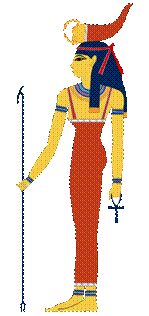
Left: Isis with the solar disk in between the horns representing the Silver Gate
Right: Serket with the scorpion at her head representing the Golden Gate.
The sacred Egyptian scarab beetle is a metaphor for the Sun in the precession cycle whereas the dung ball represents the Sun. The scarab beetle rolls its dung ball with his hind legs backwards, symbolizing the backward motion of the Sun through the zodiac in the precession cycle. Since the scarab beetle has many similarities with a scorpion, we surmise that Serket and the scarab beetle both represent the Golden Gate in Egyptian mythology.

Right: Scarab representing the crossing of the ecliptic and Milky Way
near Sagittarius-Scorpio nexus. The dung ball of Scarab beetle is the Sun.
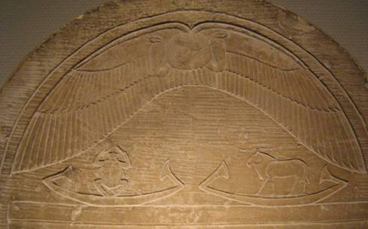
On the left, the scarab beetle in a barque. On the right, the bull with the horns in a barque. They represent the places where Ra requires a barque to cross the Milky Way river in the precession cycle and thus represents the galactic equator.
|
|
|
|
|
|
We suggest that they all represent the Silver Gate.
There is an even older Egyptian goddess that later was associated with Isis and Hathor. Her name is Serket and she was the deification of the scorpion goddess who healed stings and bites. Eventually, Serket was associated with Isis and she was said to be just an aspect of Isis. Serket and Isis can therefore be regarded as the ‘Ba of Two Faces’. While Isis represents the Silver Gate at the Gemini-Taurus nexus, Serket is her counterpart and she represents the Golden Gate at the Scorpio-Sagittarius nexus. This is why she’s wearing the scorpion on her head while she joined Ra in his barque on his journey around the zodiac in a Great Year.
 
Left: Isis with the solar disk in between the horns representing the Silver Gate
Right: Serket with the scorpion at her head representing the Golden Gate.
The sacred Egyptian scarab beetle is a metaphor for the Sun in the precession cycle whereas the dung ball represents the Sun. The scarab beetle rolls its dung ball with his hind legs backwards, symbolizing the backward motion of the Sun through the zodiac in the precession cycle. Since the scarab beetle has many similarities with a scorpion, we surmise that Serket and the scarab beetle both represent the Golden Gate in Egyptian mythology.

Right: Scarab representing the crossing of the ecliptic and Milky Way
near Sagittarius-Scorpio nexus. The dung ball of Scarab beetle is the Sun.

On the left, the scarab beetle in a barque. On the right, the bull with the horns in a barque. They represent the places where Ra requires a barque to cross the Milky Way river in the precession cycle and thus represents the galactic equator.
Dutch national museum of antiquities, Leiden.
The most interesting of female ‘horned’ Egyptian goddesses in the Egyptian pantheon is Seshat. She was the goddess of astrology mathematics architecture and keeper of the measure of time.
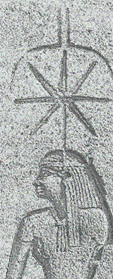
Seshat with the down turned horns and eight pointed cross.
Although interpretations differ what the cross above Seshat represents, some believe it represents a seven pointed star on a pole, other believe it represents a papyrus leaf, the authors of this article suggest that it represents an eight pointed cross, symbol of the Great Celestial Conjunction. It is placed right below the down turned horns exactly at the place where the Sun will reside during a Great Celestial Conjunction at equinoxes or solstices. Seshat headdress was called Safekh-Aubi (Sefekh-Aubi) and meant ‘She who wears the two horns’.
Seshat helped pharaoh with the alignment of the temples in Egypt in a ritual called Pedjeshes which translates into ‘Stretching the cord’ (Pedj--"to stretch," Shes--"a cord"). Armed with two pegs connected by a rope, pharaoh was accompanied by a priestess representing Seshat and aligned the temple to the celestial’s Bull’s leg while Seshat connected the other peg to her ‘home place’.
Since Seshat’s ‘home place’ is in between the horns of bull Taurus where the Sun resides at a Great Celestial conjunction and where also the eight pointed cross is depicted, the authors suggest that in the Pedjeshes alignment ritual the Pleiades as the ‘leg of the bull’ (Taurus) is being used to show the way to the place where the Sun would reside at a Great Celestial Conjunction. In this ritual the temple was aligned accordingly!
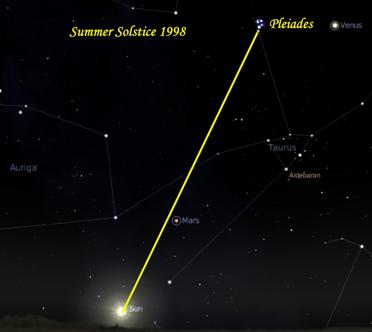 |
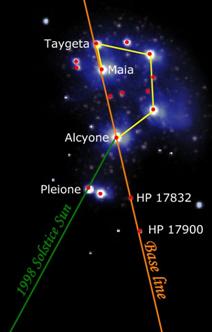 |
Pleiades as a way shower to the summer solstice Sun of 1998 (Great Celestial Conjunction era 2012)
See also Wicherink’s reinterpretation of Herschel’s conclusions on Stonehenge
Wayne Herschel mentions ‘the stretching of the rope’ ritual in his book ‘The Hidden Records’. The ‘Leg of the Bull’ (meaning the Pleiades) is mentioned in the temple of Hathor in Dendera where it is written:
“The living god Thoth – nourished by the sublime goddess in the temple – the sovereign of the country – stretches the rope in joy (align with it) – With his glance .. - ..towards the ‘ak’ of the bull’s thigh constellation.. – he establishes the temple house of the mistress of Dendera, as it took place there before”
(Wayne Herschel, The Hidden Records, pg 141)
http://www.keyofsolomon.org/gatesOfTheSun.php
|
|
|
|
|
|
La Navidad oculta http://www.akasico. com/noticia/ 732/Religiones- y-espiritualidad /navidad- oculta.html El nacimiento de Jesús que relata Mateo es el corazón del ciclo festivo del solsticio de invierno, que se extiende hasta el 5 de enero. Pero esta narración simbólica también transmite una historia real a través de la cual podemos vislumbrar el verdadero rostro del Mesías que iluminó al mundo desde Galilea. Cada año se representa la misma escena familiar: la estrella que guió a los magos de Oriente hasta el pesebre, la Virgen y el niño Jesús. Son imágenes inspiradas en El Evangelio según Mateo, que preceden a la Huida a Egipto y a la matanza de los inocentes. Pero pocos advierten que este relato encierra una historia oculta y un misterio fascinante. Para muchos autores se trata de una «leyenda» sin contenido histórico. Las estrellas no se mueven. Tampoco existe mención de una matanza de niños en otras fuentes. Sólo Mateo narra estos hechos. Por tanto, su conclusión es que éste inventó un suceso milagroso para rodear el nacimiento del Mesías cristiano de grandes prodigios en el Cielo y en la Tierra. El resultado habría sido el mito de la Natividad, completado entre los siglos II y IV por apócrifos como el Pseudo Mateo. La Estrella y los Magos Sin embargo, la estrella que tanto ha dado que hablar sirvió de guía a todas las culturas antiguas, como un auténtico faro celeste. Era Sirio, la estrella-perro (guía) de la constelación de Orión. En los días de Jesús, los sabeos mandeanos rindieron culto a «la Estrella-guía» . Al parecer, Juan el Bautista fue un mandeo. Y la conexión de esta corriente judía heterodoxa con Egipto era estrecha: peregrinaban a Giza, creían que las tres pirámides de dicha meseta eran las tumbas de sus profetas Set e Idris (Enoch) y reivindicaban una religión adámica de la cual había sido seguidor Abraham, el primer antepasado de Jesús en la genealogía de éste que recoge Mateo. Y ciertamente, la «Estrella-guía» de los mandeos (Sirio), se movía: su ascenso en el Cielo precedía a Orión, cuyo cinturón tachonaban tres astros rutilantes: tres magos que peregrinaban en el firmamento de Oriente. Las pirámides de Giza habían sido concebidas por los antiguos egipcios como un reflejo de estos tres astros del cinturón de Orión sobre la Tierra. En esta cultura, Orión era Osiris, el dios muerto y resucitado por su esposa Isis, identificada con Sirio. Como para ellos Escorpio era el falo del Osiris celeste y dicha constelación se ocultaba cuando se levantaban Sirio y Orión, la procreación del dios hijo Horus se había consumado sin intervención del sexo de Osiris, devorado por un pez. El milagro se repetía todos los años y su signo era la inundación del Nilo, el reflejo en la Tierra de la Vía Láctea. La conexión egipcia de la Navidad cristiana aparece en Mateo desde el principio. La genealogía de Jesús se compone de 3 tramos de 14 generaciones cada uno. Y Mateo añade algo obvio: si sumamos el segundo tramo de 14 al primero obtenemos 28 y, añadiendo el tercero, hacen un total de 42. Los tres números son claves del mito de Osiris, que en el año 28 de su reinado fue asesinado y mutilado en 14 trozos por su hermano Seth. Después, el dios fue resucitado por su esposa Isis, asistida por el dios Thot, que había compendiado la suma de la sabiduría divina revelada a los antiguos egipcios en 42 libros secretos (el total que suman las generaciones en Mateo). Con este simbolismo, éste nos señala la pista egipcia, precisamente el país hacia donde se dirige la Sagrada Familia después de la Adoración de los Magos. En su genealogía Mateo incluye a 5 mujeres. ¿Por qué sólo 5 entre 42 posibles? La respuesta es fácil. La estrella de 5 puntas representaba el dominio estelar y el número sagrado de Horus, símbolo de sus ojos y de su linaje divino: el Sol paterno (3) y la Luna materna (2). Y otro indicio de que la Estrella de Belén era Sirio, representada como estrella de 5 puntas en la cultura del Nilo y por los iniciados.El número 5 y su figura geométrica asociada (pentágono), que dio lugar al Pentagrama €“estrella de cinco puntas inscrita en el círculo€“, tenía un profundo significado místico. Por el hecho de unir al primer par (2, número femenino) y al primer impar (3, masculino) era considerado un símbolo nupcial. Así lo interpretaban también los pitagóricos griegos, entre quienes fue un signo de reconocimiento entre iniciados, como la imagen del pez para los primeros cristianos, evocadora del pez que devoró el falo de Osiris y también del misterioso pez-profeta, hermano de Horus, en una variante del mito egipcio que transmite Plutarco, en la cual este dios hijo se autoengendra en Edfu. Como el pez (Piscis), también el 5 tenía resonancias astronómicas entre los griegos, porque se asociaba a los cinco planetas conocidos y especialmente a Venus, antigua diosa madre. Mateo nos transmite así la naturaleza divina de Jesús desde su nacimiento: el cumplimiento de una promesa revelada a todas las culturas desde la noche de los tiempos. El Hijo de Dios había encarnado aquella noche que conmemora la Navidad. La Estrella-guía Sirio condujo a los magos celestes del cinturón de Orión. Al iluminar el pesebre, éstos derramaron la gracia de Dios sobre el niño: incienso (santidad), mirra (sabiduría y resurrección) y oro (realeza). Ni la Estrella-guía ni los magos faltaron en aquel establo. Esta conexión egipcia está bien documentada. En sus Anales, el historiador romano Cornelio Tácito €“que fue miembro experto de una comisión imperial para asuntos religiosos€“, afirma que los judíos formaban «una sola superstición con los egipcios». Tácito se refería a los primeros cristianos, que se consideraron judíos hasta su separación de la sinagoga, consumada bajo Nerón. La matanza de los inocentes No hay otros documentos, aparte de Mateo, que recojan la matanza de los inocentes. Pero cuando Jesús tenía aproximadamente 12 o 14 años, los soldados de Roma pasaron a cuchillo a la población de Séforis, capital de Galilea muy próxima a Nazareth, debido a la revolución del censo. Esta masacre tuvo lugar hacia el año 6-7 d.C. Jesús debió contemplar muchas veces las ruinas de Séforis. En sus días, las matanzas de inocentes en Galilea fueron frecuentes. Mateo no recogió un hecho histórico literal con el episodio de la matanza de Belén, pero tampoco ideó una fantasía. Simplemente, elaboró un midrash, un género característico de los judíos que consiste en un relato simbólico en el cual se recogen los antecedentes bíblicos de un hecho, a través de los cuales se expresa su significado trascendente. Este era el método para explicar las causas de la historia en su cultura. Los símbolos que representaban dichas causas tenían para ellos el mismo valor que concedemos hoy a los factores económicos, políticos y sociales. Y como éstos, explicaban los hechos históricos desde el punto de vista de aquella cultura. En este caso, Mateo evoca la profecía de Oseas (13,16), que se refiere a la destrucción del reino del norte de Israel por los invasores asirios (722 a.C.). Oseas describe la desgracia de su capital (Samaria): cómo sus «niños fueron estrellados» y sus pobladores «pasados a cuchillo». Este episodio sirve como antecedente evocador de muchas matanzas, como la de Séforis, pasada a cuchillo por los nuevos invasores romanos. Mateo alude a Oseas, porque éste asocia la masacre de niños a su profecía de un Mesías que redimiría a Israel. Y como es característico del midrash, también evoca otras profecías afines. Entre ellas, la de Isaías, que se refiere a un niño a quien llamarán Dios y Príncipe de la Paz (9, 6), después que el pueblo vea «una gran luz» (9,2), aludida por el Evangelio como la Estrella-guía. De este modo, Mateo reviste a Jesús con los signos del Mesías anunciado por Isaías, Oseas, Miqueas y Jeremías. Un Enviado que uniría los reinos del norte (Efraim) y del sur (Judá), así como a los desterrados por Asiria y a los esparcidos en Babilonia de todas las tribus de Israel. La palmera escondida Entre las 5 mujeres que menciona Mateo en su genealogía de Jesús, la primera es Tamar, nombre que significa «palmera», y la segunda Rahab, mujer de Jericó, una población conocida como «la ciudad de las palmeras». La intención simbólica de Mateo sería recogida por la tradición del Islam en el sura XXI del Corán, según el cual la Virgen María sufrió los dolores del parto bajo una palmera que le alimentó. El Evangelio nos sitúa así ante un símbolo sagrado común a todas las culturas antiguas para expresar el alcance universal de la misión de Jesús. En Egipto, la palmera datilera aparece asociada a las diosas madres, como Hathor y Nut. En Mesopotamia es el árbol consagrado a la diosa Isthar. En Persia, fue la representació n del Árbol de la Vida. También se vincula con la resurrección, ya que el Fénix hacía su nido en una palmera. Este simbolismo, que recogen Plinio el Viejo y otros autores antiguos, dio lugar a la artesanía ritual de la palma blanca como ofrenda a las diosas madres vírgenes, que después sería transferido a la Virgen María. Su elaboración se conseguía envolviendo las hojas de palma para que no las tocara el Sol masculino y se preservaran así como un atributo femenino puro, relacionado con la concepción virginal. Actualmente, aquella antigua artesanía tiene su último reducto en la ciudad española de Elche, donde un grupo de familias sigue transmitiendo de padres a hijos el arte de tejer ramos y coronas para la Virgen con estas palmas blancas. Este palmeral histórico de Elche hoy es «Patrimonio de la Humanidad». La misma Humanidad a la que Mateo dirigió su evangelio, más allá de su auditorio judío. Por eso, inicia su genealogía con la misma frase que emplea el Génesis para introducir la descendencia de Adán, aunque sólo se remonte hasta Abraham: «Este es el Libro de las generaciones de Jesucristo». Y por idéntico motivo, Lucas complementó a Mateo en su texto, prolongando su genealogía hasta Adán. Para enfatizar el simbolismo de estas genealogías €“y no para contradecir a Mateo€“, Lucas siguió una línea davídica no real a partir del rey David. Pero nada de esto excluye que el Evangelio refleje los hechos históricos. Sólo que sus autores entendían la historia como hombres de su tiempo. La Huida a Egipto que aparece en Mateo transmite el simbolismo que hemos expuesto, pero eso no significa que Jesús no viajara a Egipto. En el Talmud judío se le acusa de haber traído de allí conjuros mágicos. En su Discurso contra los cristianos, Celso afirma que fue un pobre emigrante en Egipto, donde habría trabajado como jornalero. El obispo episcopaliano John Shelby Spong, en su libro Jesús, hijo de mujer (Ed. Martínez Roca), también considera que Jesús creció en un medio de pobreza. ¿Nació de una virgen? Mateo se remite a la profecía de Isaías 7, 14-23, pero la toma de la traducción griega de la Biblia. Dicha versión tradujo el término hebreo almah (mujer joven) por el griego parthenos (virgen), cuyo equivalente hebreo es bethulah, no almah. Sin duda, hubo algo irregular en el nacimiento de Jesús. Marcos no menciona ninguna concepción virginal e identifica a Jesús como «el hijo de María», aparte de referirse de pasada a ciertos rumores que rodearon su nacimiento, cuyo contenido él no recoge ni comenta en su texto. El Talmud y Celso lo califican de fruto de un adulterio de María. Y Mateo parece responder a estas acusaciones con las 4 mujeres que la preceden en su genealogía, porque éstas tienen en común una imagen estigmatizada desde el punto de vista de las costumbres judías, pero también fueron objeto de una injusticia manifiesta o bien víctimas inocentes de las circunstancias. Cada uno es libre de dar crédito a la fuente que encuentre más fiable. Unos creen en el milagro de la concepción virginal, otros ven en el símbolo de «la virgen de Dios» una verdad espiritual que no se refiere a una realidad física y hasta hay quienes hacen juicios de intención, atribuyendo a Mateo la voluntad oportunista de ganarse a los paganos habituados al mito de la madre virgen de un dios-hombre. En cualquier caso, resulta significativo que Mateo no recoja en su genealogía a ninguna de las madres impecables de Israel desde el punto de vista étnico €“Sara, Raquel y Lía€“, sino sólo a esas 4 mujeres estigmatizadas y extranjeras, provenientes de linajes considerados malditos por los judíos, como los moabitas (Ruth) y cananeos (Tamar y Rahab), o bien sometidos al vasallaje como los hititas (Betsabé). ¿Quiso representar Mateo en esas mujeres los 4 brazos de la cruz histórica de María? ¿Era una mujer sin linaje? ¿Acaso una humilde espigadora que recogía la sobras de la cosecha caminando detrás de los jornaleros como Ruth? El círculo de los gentiles Probablemente, el nacimiento no ocurrió en Belén de Judá. Esta localización parece simbólica y apunta a identificar a Jesús con el Mesías esperado por los judíos, para quienes debía ser descendiente de David, cuya cuna legendaria era Belén. Pero también en este punto el Evangelio parece inspirado, ya que, en el oráculo primitivo hebreo, la profecía de Miqueas 5,3 no mencionaba a Belén, sino a Efrata. Y este nombre evoca a Efraim, una de las denominaciones que la Biblia emplea para referirse al reino del norte de Israel, destruido en el siglo VIII a.C. por los asirios, al que había pertenecido la región que fue conocida como Galilea en los días de Jesús. Las otras denominaciones bíblicas de este reino del norte fueron «reino de Israel», «reino de José» €“nombre evocador de Egipto a través de este hijo de Jacob, casado con una hija del sacerdote egipcio Potifera€“ y Samaria. Jesús destacó como defensor de esta población despreciada por mestiza y herética. Más aun: junto al pozo de Jacob se presentó ante la mujer samaritana como el Mesías que ella esperaba, según Juan. Eso indica que Jesús se identificó con el Taheb, el Mesías samaritano. De modo que Belén pudo ser una localización simbólica del midrash, a través de la cual se proyectaba el hecho de que Jesús había nacido en Efraim (Efrata), región que había incluido a Galilea y cuya capital fue Samaria, otro nombre dado al reino del norte en la Biblia. Ninguna de estas circunstancias merma grandeza a Jesús, aunque le añada sufrimiento a ese «varón de dolores» que había profetizado Isaías. ¿No era acaso lo propio del Mesías de los pobres y humillados un nacimiento irregular y calumniado, en medio de la pobreza y en un rincón oscuro de la remota Galilea, despreciada por los judíos de Jerusalén como tierra mestiza? Hasta el nombre de esta región donde estaba Nazareth (Galil hoyim), tenía connotaciones evidentes de «impureza racial», puesto que significaba «círculo de los gentiles». La Huida transmite otro mensaje importante que, en general, ha sido interpretado sólo desde una perspectiva judía ortodoxa. Mateo habría comunicado con dicho episodio que Jesús era el nuevo Moisés, evocando con este midrash el episodio bíblico en el cual el faraón ordena ahogar en el Nilo a los niños varones de Israel. Sin embargo, cabe preguntarse si su intención no fue aludir también a otro antecedente bíblico que no pudo pasarle inadvertido, porque encaja mucho mejor con la masacre de Belén: la matanza de niños edomitas perpetrada por Joab, general del rey David, que estuvo a punto de dejar sin varones a Edom (I Reyes, 11). De este cruel genocidio sólo se salvó el pequeño príncipe Hadad, que huyó a Egipto para regresar siendo hombre y proclamar la independencia de Edom. Así se cumplía la promesa que Yavhé había hecho a Esaú, primogénito de Isaac y padre de Edom, despojado de su derecho como heredero en beneficio de su hermano menor Jacob (Israel). Hay una evidente simetría entre la matanza de Belén ordenada por el idumeo Herodes €“Idumea nació de Edom€“ para eliminar a un supuesto heredero davídico (Jesús) y la de Joab, ordenada por David para eliminar al heredero de Edom. ¿Simbolizó Herodes el Grande la venganza de Edom en el midrash de Mateo? ¿Empezó su vida Jesús expiando este pecado de Israel y cumpliendo desde su nacimiento esa función mesiánica que había profetizado Isaías? Los edomitas se consideraban descendientes de Ismael (padre de los árabes), a través del matrimonio de una de sus hijas, llamada Bashemat, con Esaú. Ismael también había sido despojado de sus derechos en beneficio de su hermano menor Isaac, ya que era el primogénito de Abraham, el primer nombre en la genealogía de Jesús que nos transmite Mateo. En I Reyes también se narra otra Huida a Egipto: la de Jeroboam, efrateo de Sereda, hijo de Nabat. El profeta Ajías le anunció que fundaría el reino del norte como líder de 10 de las 12 tribus de Israel y Salomón quiso matarlo (I Reyes, 11). Como sucedió con Hadad, Jeroboam también encontró refugio en Egipto, de donde regresó para independizar a Israel del reino de Judá. Sin duda, existe una base sólida para pensar que el Evangelio recoge un hecho histórico importante que pudo tomar forma de proyecto mesiánico en la época de Jesús. Todas las profecías bíblicas que evoca se sitúan en la época de la destrucción del reino del Norte (siglo VIII a.C.). También anuncian a un Mesías libertador, que un profeta del norte como Oseas (1, 11) identifica simbólicamente con Jezreel, de quien nos dice que «su día será grande» y que unirá a Efraim (norte) y Judá (sur) bajo «una sola cabeza». Incluso presenta imágenes muy sugerentes en relación a Jesús: «al tercer día nos resucitará y viviremos delante de él» (Oseas 6,2). A su vez, Isaías y Miqueas, profetas del sur y contemporáneos de Oseas, aluden a los mismos hechos, aunque destacan que el Mesías vendría del tronco de Isaí (padre de David), como nueva «rama», «vara» o «renuevo». La Raquel que llora a sus hijos en Ramá €“también evocada en el Evangelio€“, proviene de Jeremías y también alude a la destrucción del reino del norte. Una posibilidad es que estemos ante los vestigios de un hecho histórico: la proclamación de un Mesías galileo, enviado por Dios como representante de todos esos linajes nacidos de primogénitos despojados, que habían dado lugar a distintos pueblos semitas emparentados entre sí y que tenían en Abraham su padre común. En este caso, el Mesías galileo debía nacer simbólicamente en Belén para tomar el relevo del linaje davídico, como en su día David (de la tribu de Judá) había tomado el testigo de la función real, que hasta entonces había recaído en el rey Saúl, de la tribu de Benjamín. Por eso, una vez ungido, David desposó a Mikal, hija del depuesto Saúl. Por lo tanto, el nacimiento simbólico en Belén pudo ser un equivalente de la boda de David con Mikal: la forma en que el nuevo ungido de Dios tomaba el relevo al frente del pueblo elegido, legitimándose como sucesor al asumir un vínculo con el linaje desplazado que simbolizaba la continuidad sagrada. Este recurso es un tópico bíblico recurrente. Dios quita con frecuencia los privilegios otorgados a un individuo o a un linaje y los da a otros. También es importante advertir que, en el evangelio de Juan, Jesús replica a los saduceos que el Mesías no tiene por qué pertenecer al linaje de David, puesto que éste le reconoce como «Señor de mi Señor». A su vez, en la Epístola a los hebreos se compara a Jesús con la figura legendaria de Melquisedec, el misterioso rey de Salem, de quien se nos dice que no tenía padre ni linaje, pero a quien Abraham había reconocido como al sacerdote perfecto y pagado el diezmo. Hebreos afirma que, como Melquisedec, Jesús está por encima de cualquier linaje humano porque su autoridad emana de «una vida indestructible» . Por ello, este texto cristiano funda la Nueva Alianza sobre el Orden de Melquisedec y sostiene que es superior al aarónico-levítico de Judá. Todo sugiere que Jesús pudo ser un Mesías galileo que proclamó un ambicioso proyecto de unificación nacional, mucho más amplio del que estaban dispuestos a admitir los judíos del sur. Debía llegar cumpliendo la profecía en la cual Dios había anunciado: «De Egipto llamaré a mi Hijo». Y todas las fuentes €“incluso las hostiles€“ indican que residió allí, porque ésta era la tierra de origen de todos los descendientes de Abraham. Dicho proyecto mesiánico pudo incluir a todas las tribus de Israel (Jacob), a la población «mestiza» del reino del norte (Galilea y Samaria) y, tal vez, a ismaelitas (árabes), idumeos (edomitas), y nabateos, que descendían de otra hija de Ismael casada con Esaú. El origen de la Nueva Alianza En los días de Jesús el reino nabateo de Siria vivió sus años de mayor esplendor (entre el 6 a.C. y el 40 d.C). El Evangelio afirma que Juan el Bautista fue asesinado por Herodes Antipas porque éste denunció su matrimonio con Herodías. Al unirse a ésta, Herodes abandonó a su primera esposa, hija del rey nabateo Aretas. Flavio Josefo sostiene que Herodes Antipas mandó matar a Juan «porque soliviantaba el pueblo». Nada impide que el motivo incluyese, precisamente, esa afrenta a los primos nabateos, motivo por el cual el rey Aretas atacó y derrotó a Herodes Antipas en el año 36. Siria fue un lugar de asentamiento de las comunidades mandeas del Jordán, como la del Bautista. Otro indicio que señala en la misma dirección es que Siria, Samaria y otros territorios vecinos, sirvieron de refugio a los cristianos cuando huyeron de la primera gran persecución desatada en Jerusalén. Esto prueba que allí existía una base social favorable en los años inmediatos a su crucifixión. Por motivos cronológicos obvios, ese clima social favorable tuvo que cimentarse en vida de Jesús. ¿Estamos ante indicios de cuál fue el auténtico origen histórico de la Nueva Alianza entre Dios y la Humanidad? ¿Nos transmite la Natividad de Mateo el hecho histórico que sirvió de embrión a la religión universal del cristianismo, recogido por Lucas al prolongar de forma intencionada su propia genealogía de Jesús hasta Adán? De algo podemos estar seguros: se trata de un escenario muy probable a la luz de las fuentes disponibles. ____________ _________ _________ __ "Visita Interiora Terrae Rectificando Invenies Occultum Lapidem" - 7.
-
-
|
|
|
 Primer
Primer
 Anterior
2 a 11 de 26
Següent
Anterior
2 a 11 de 26
Següent Darrer
Darrer
|
|
| |
|
|
©2025 - Gabitos - Tots els drets reservats | |
|
|

